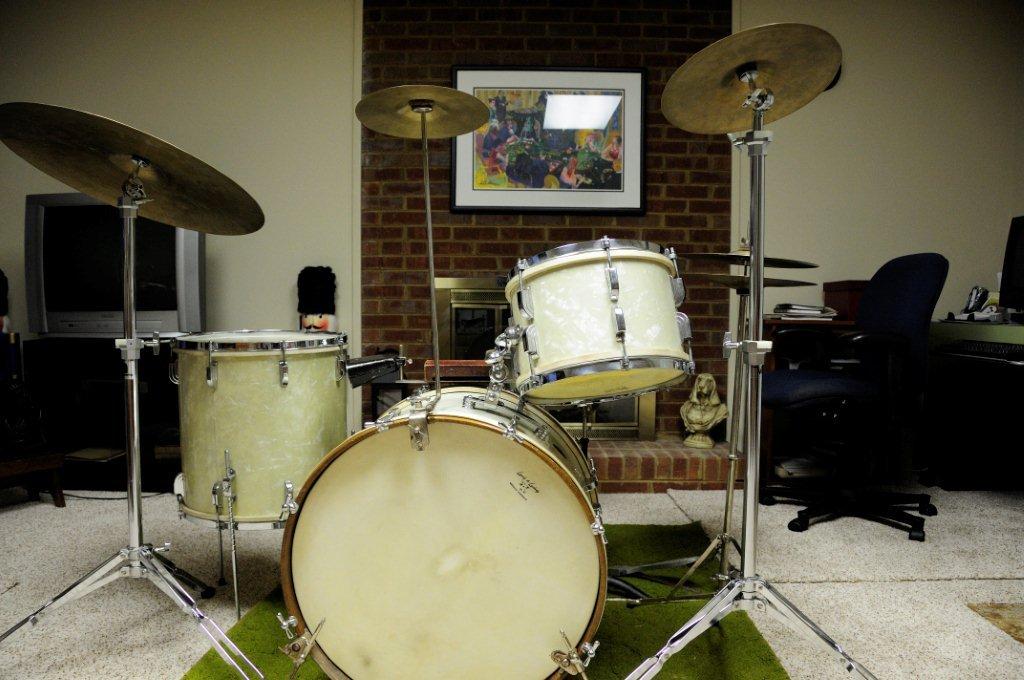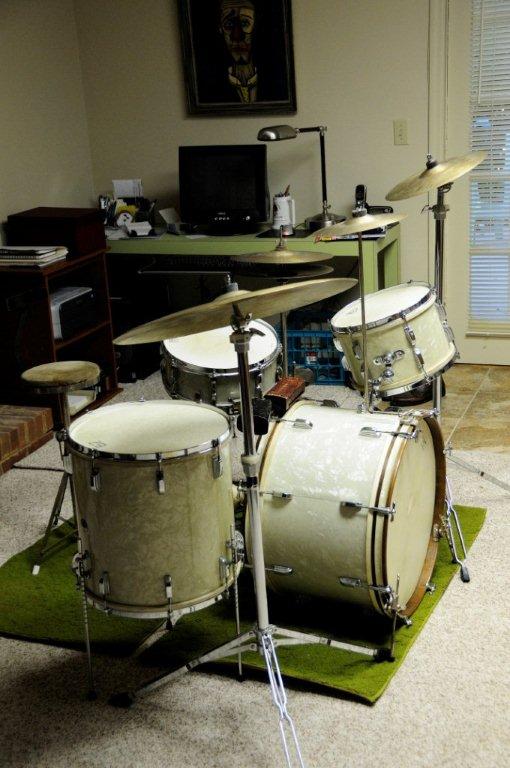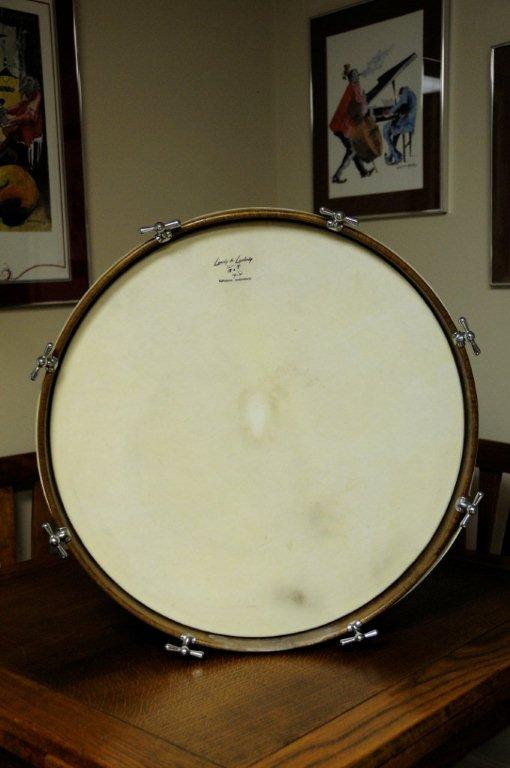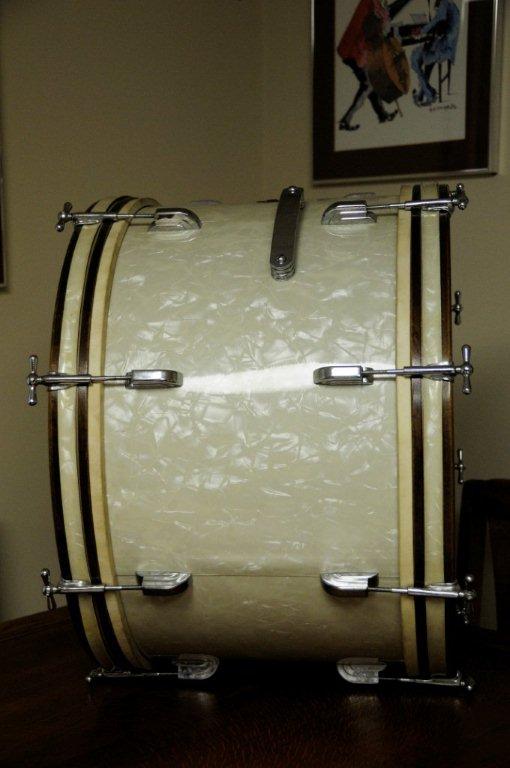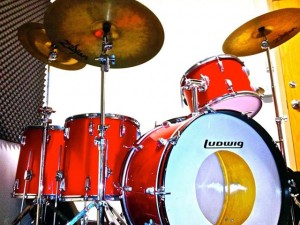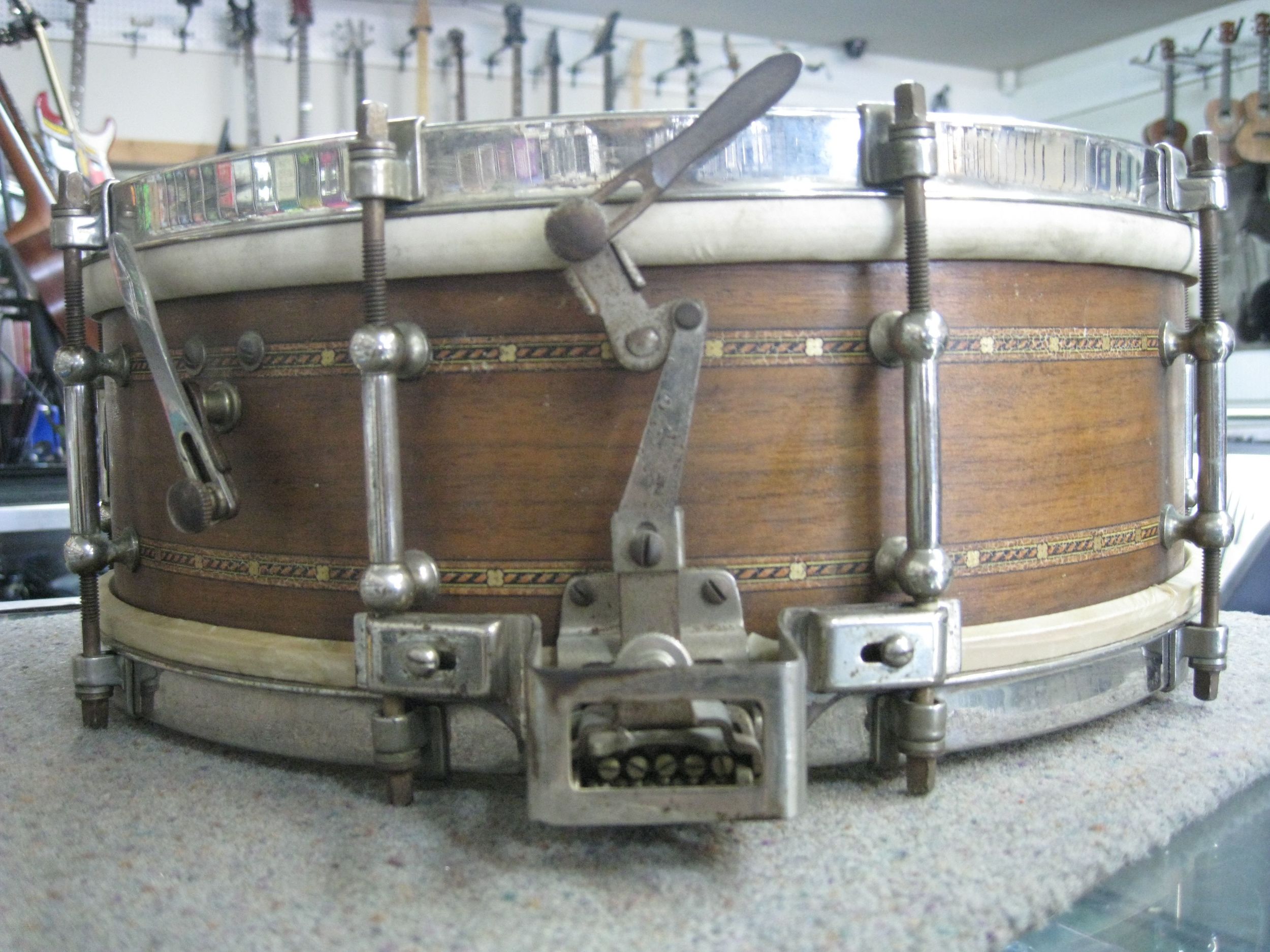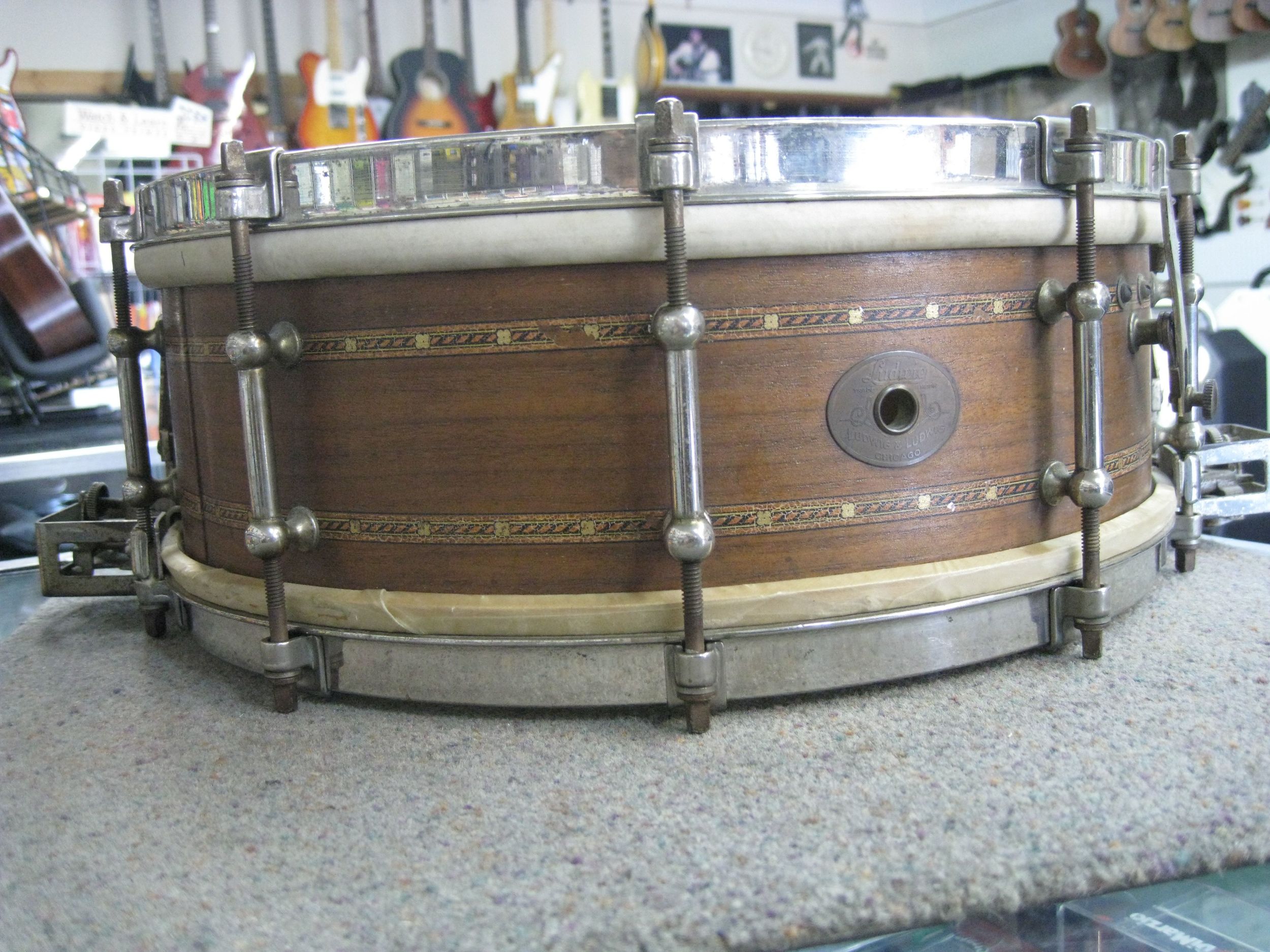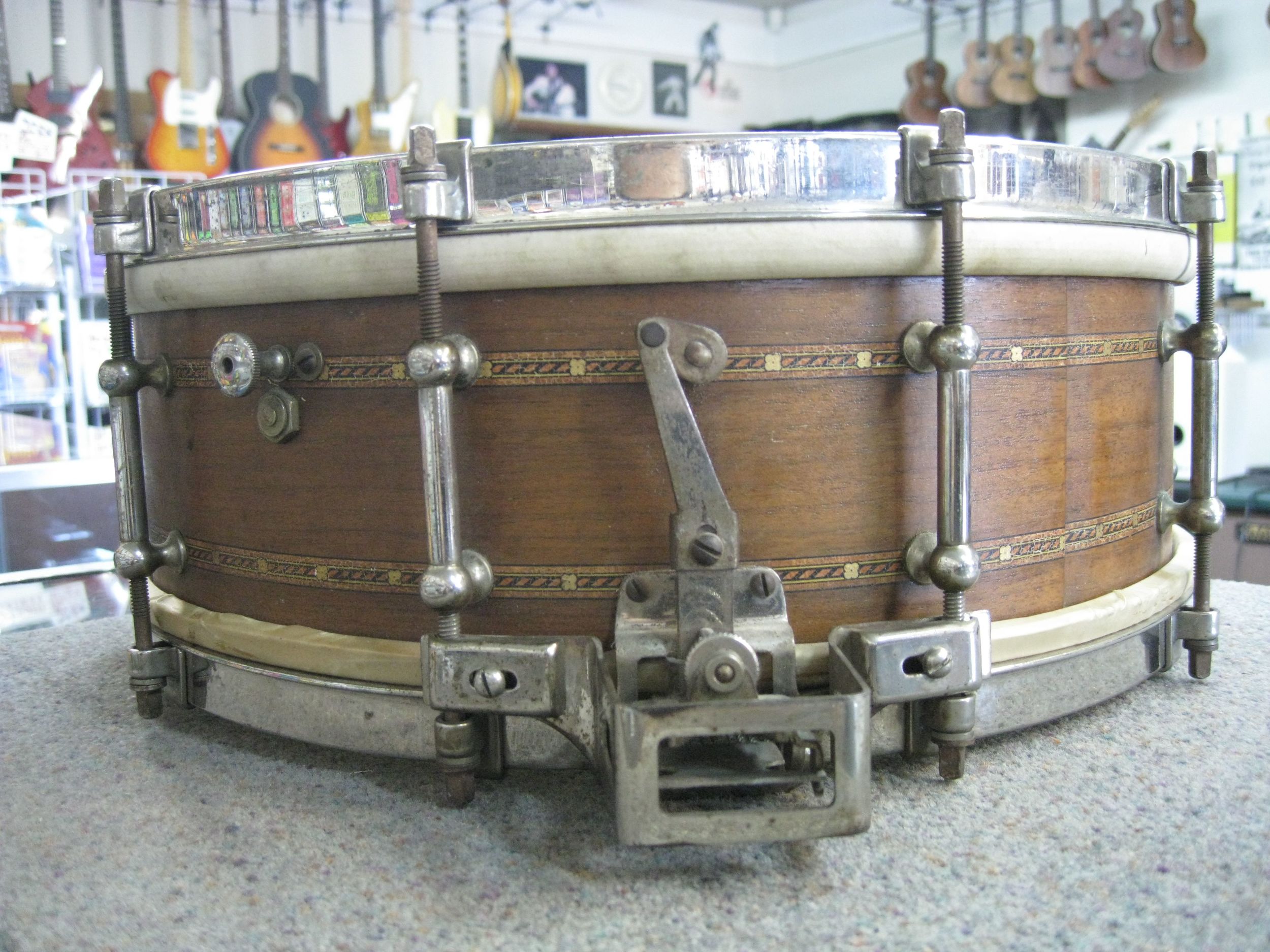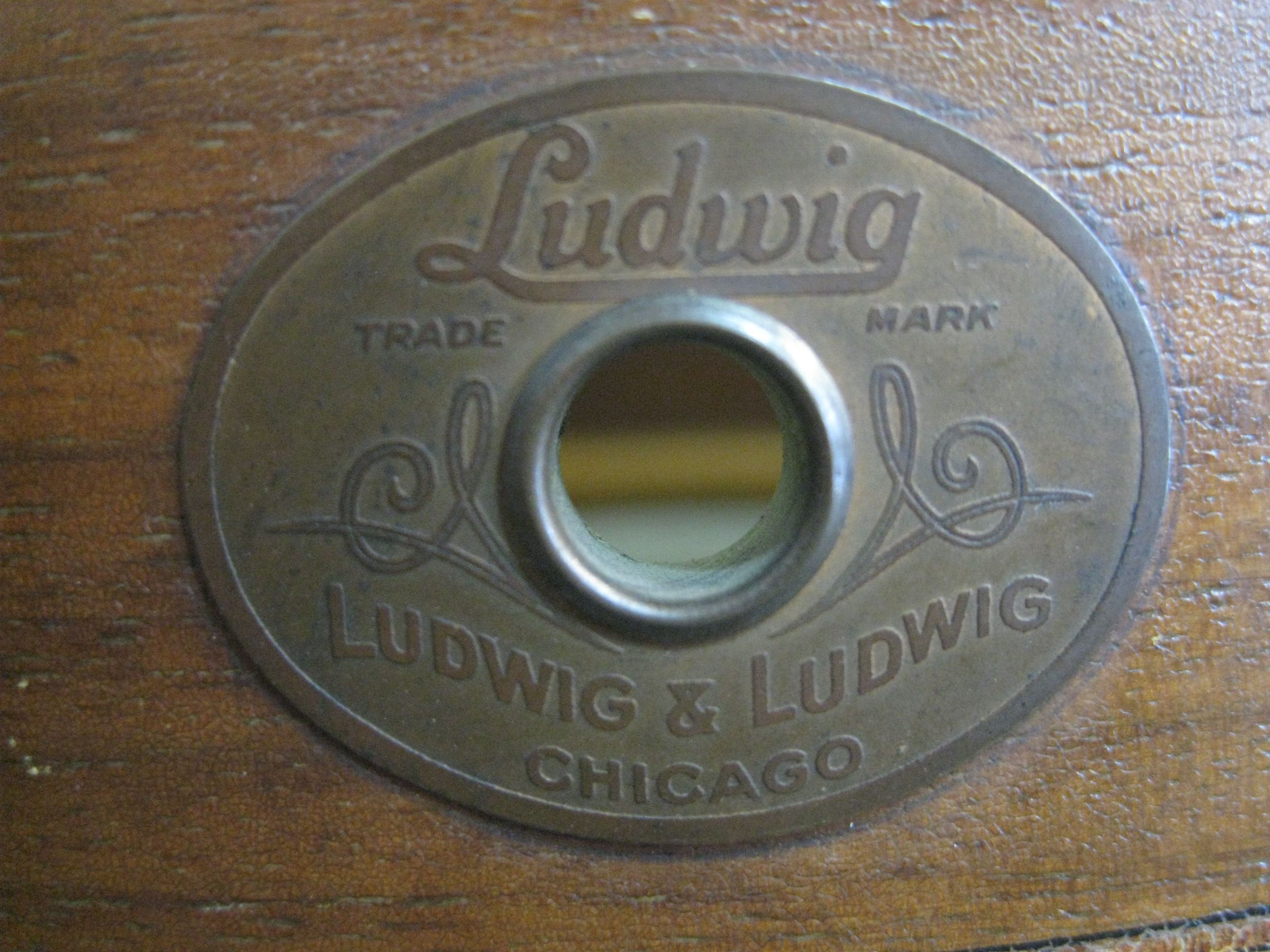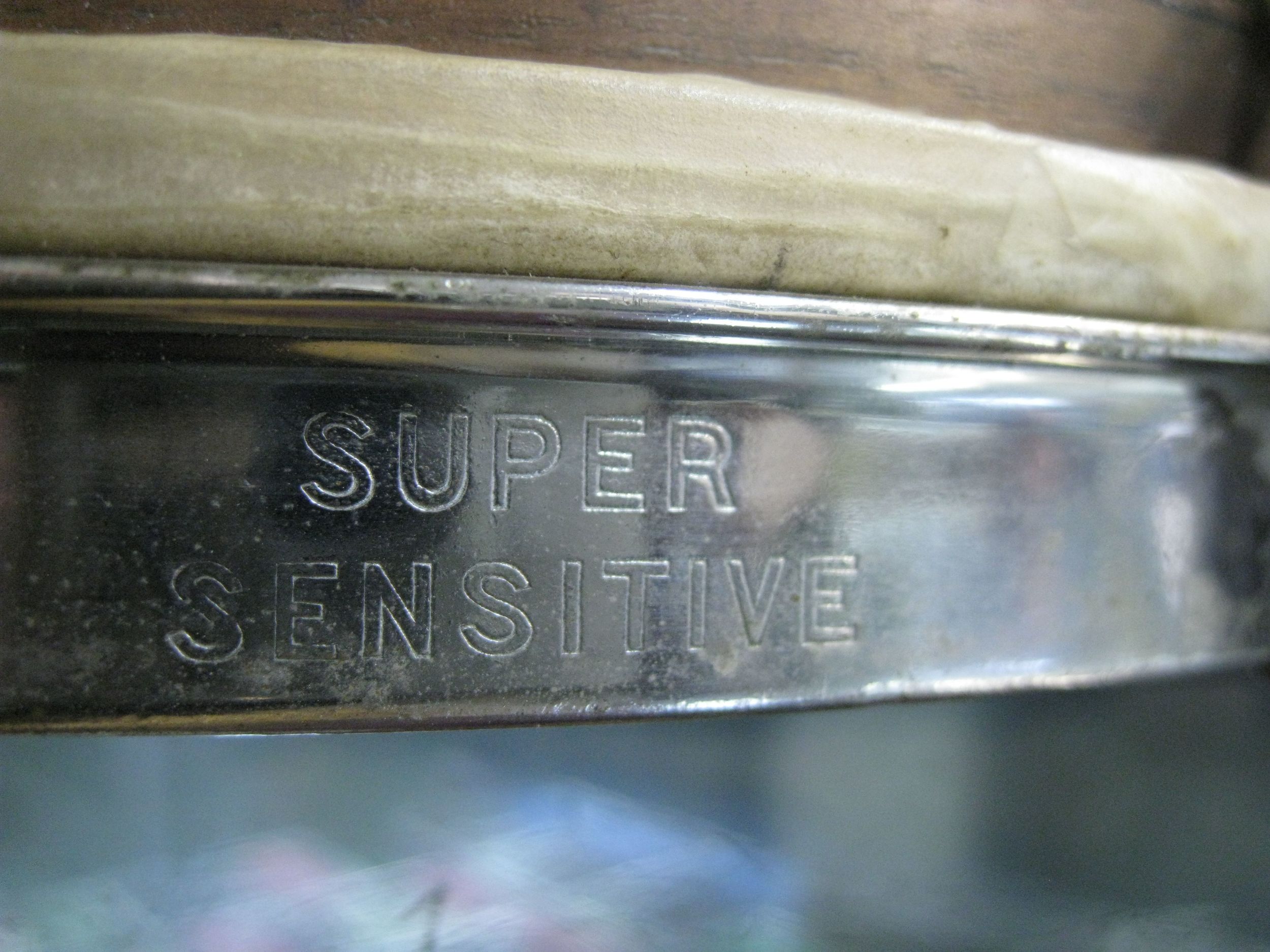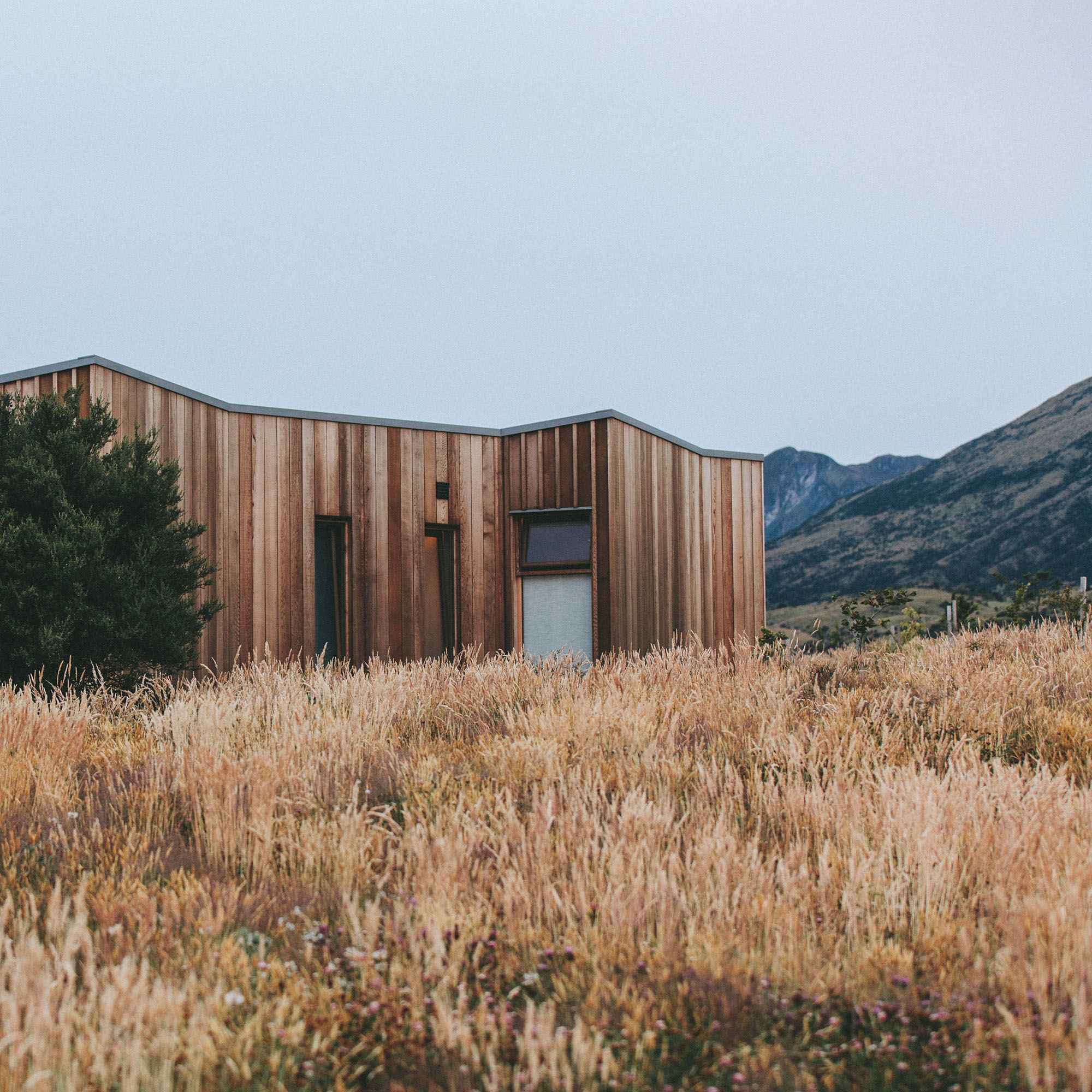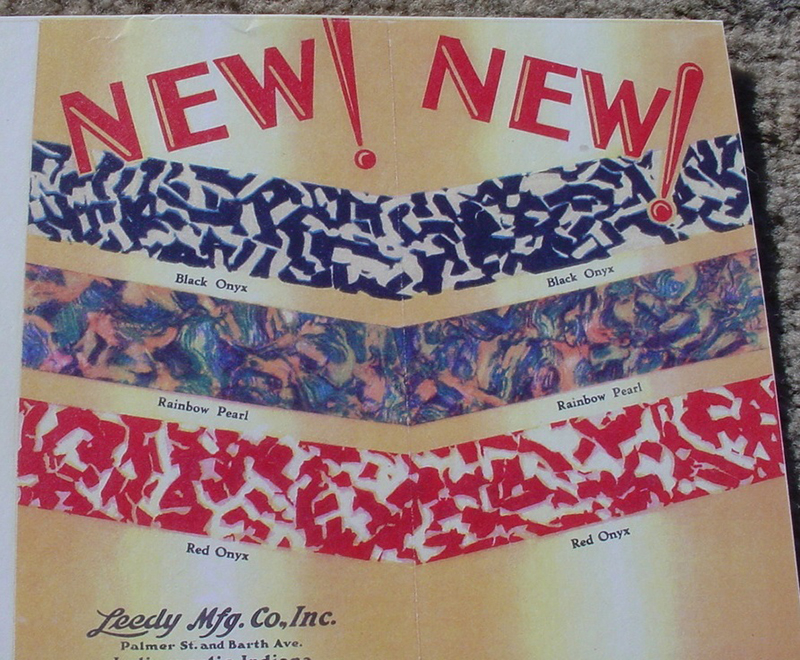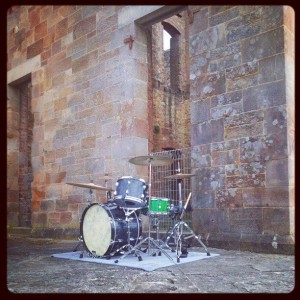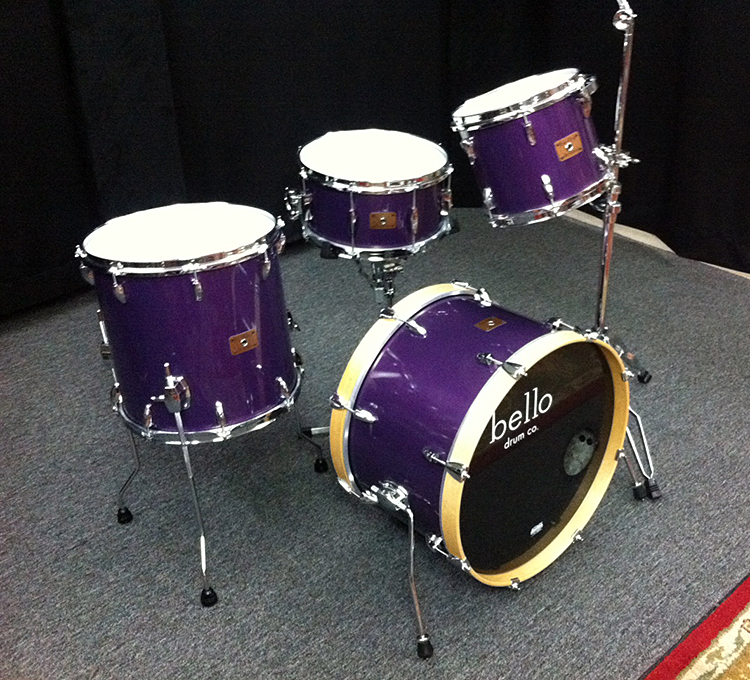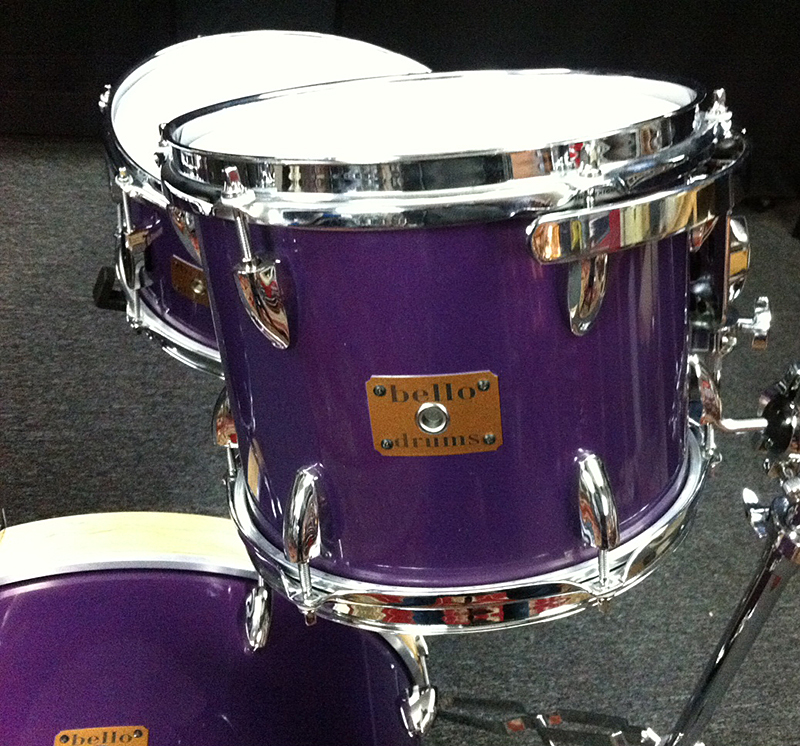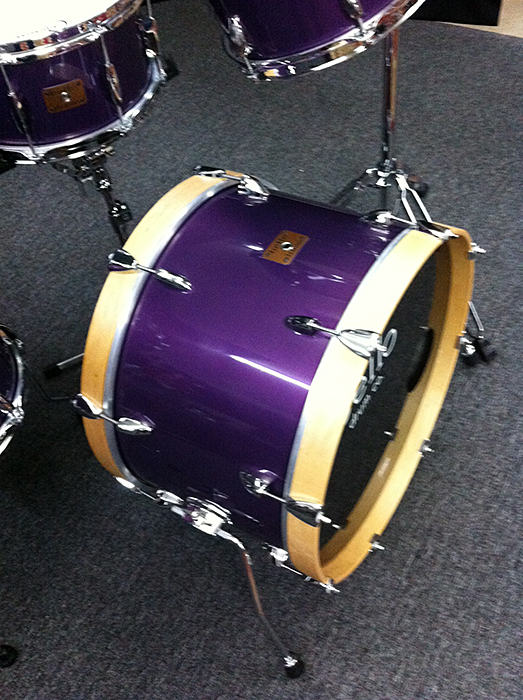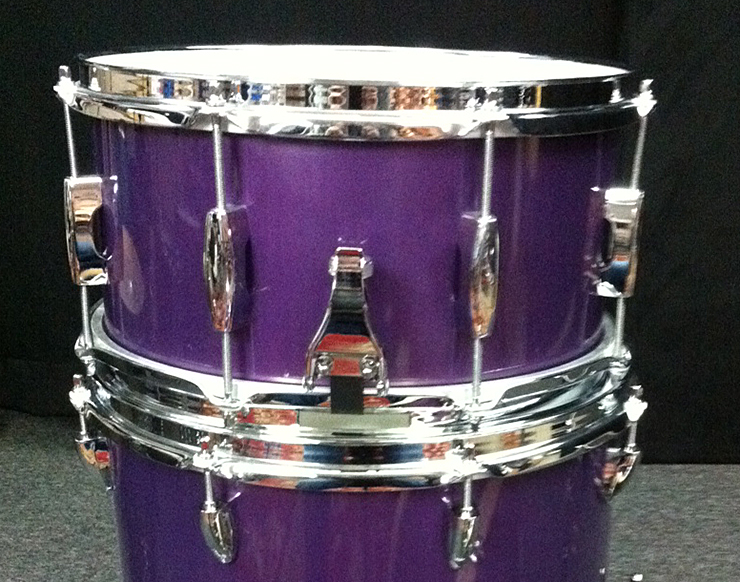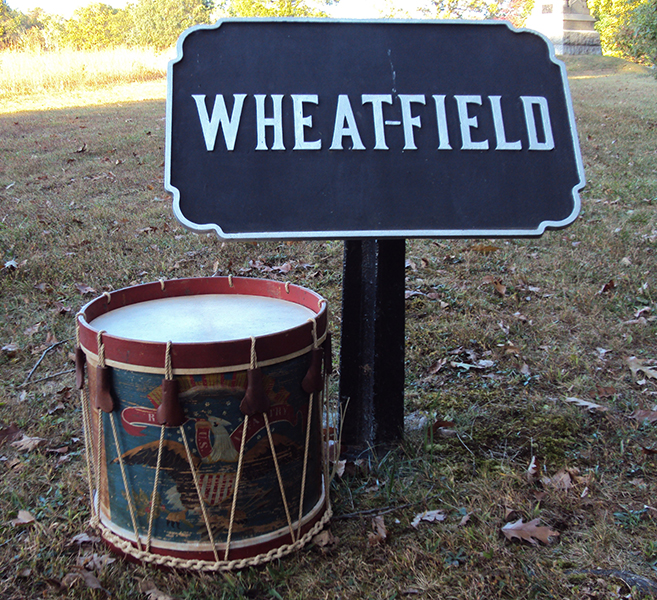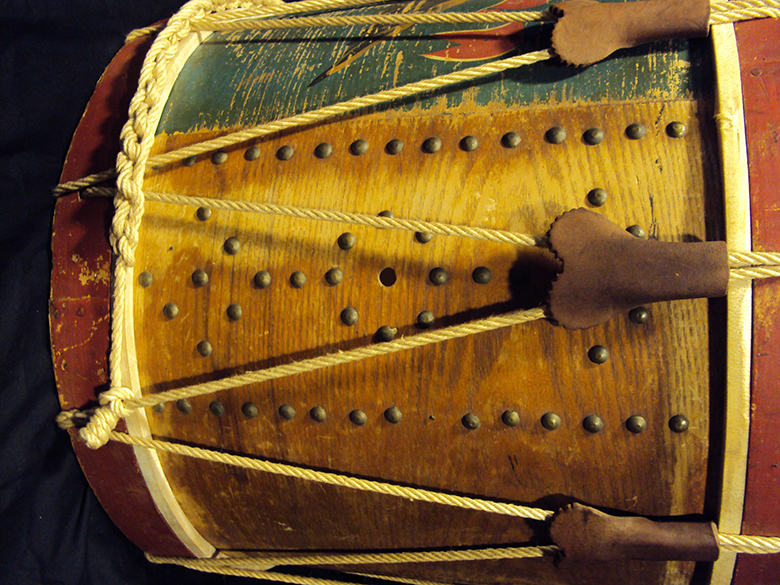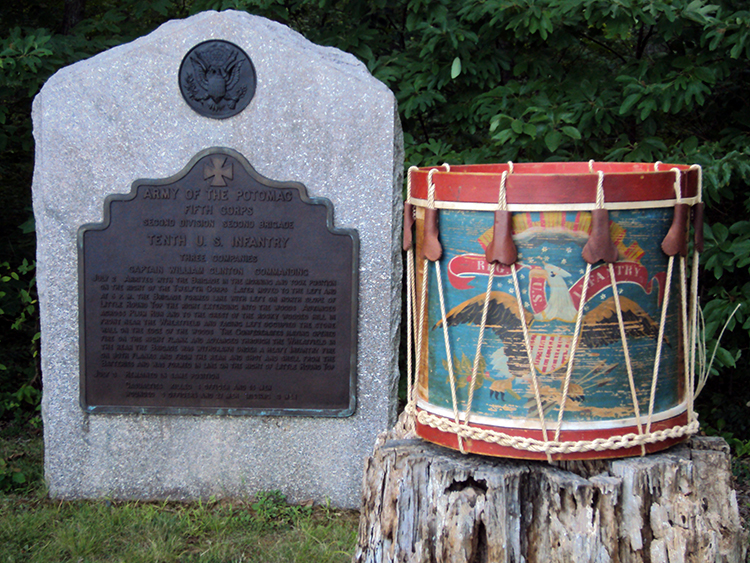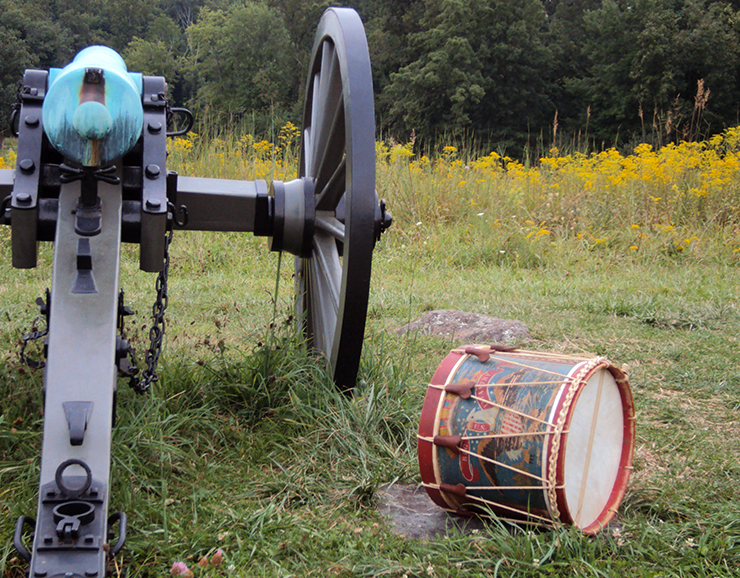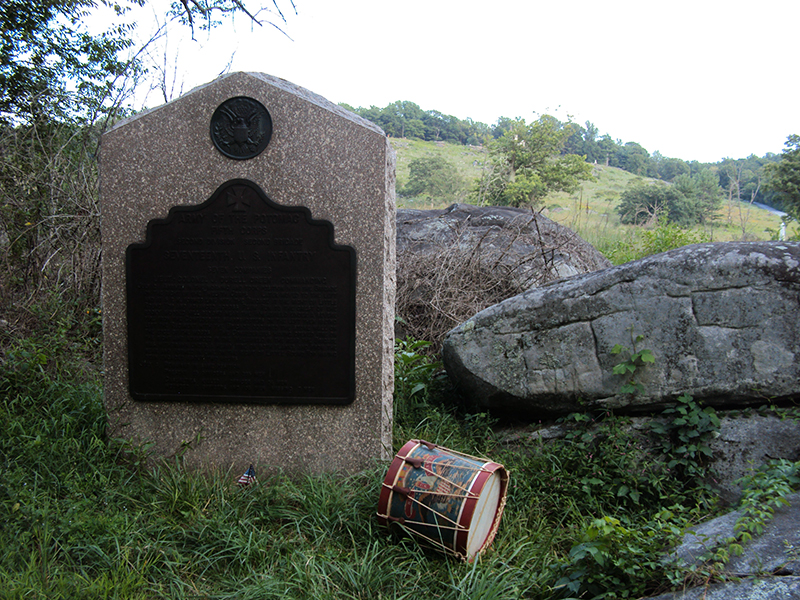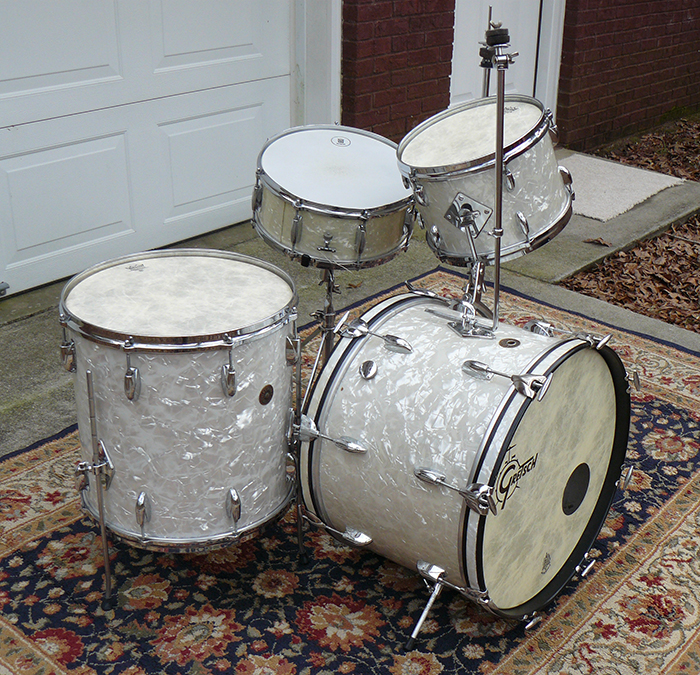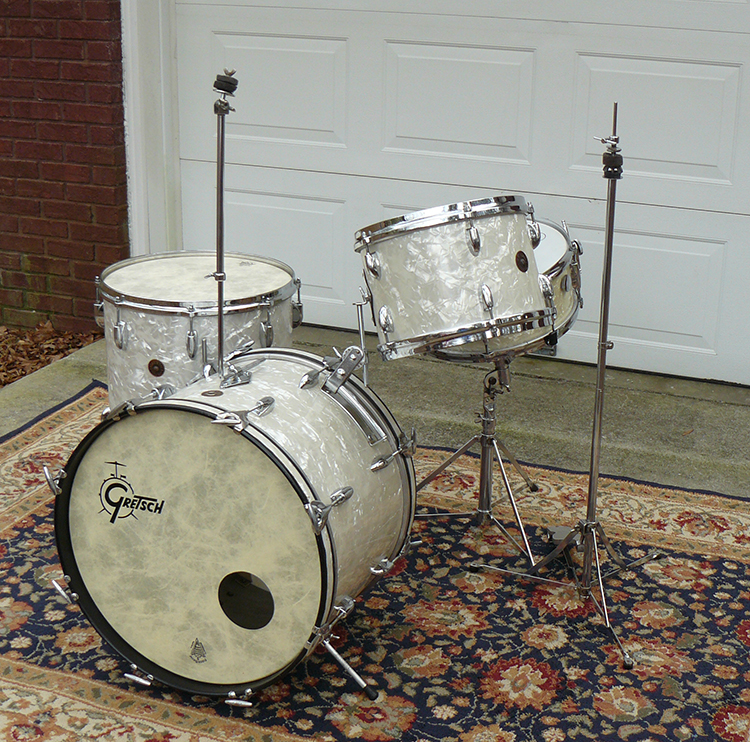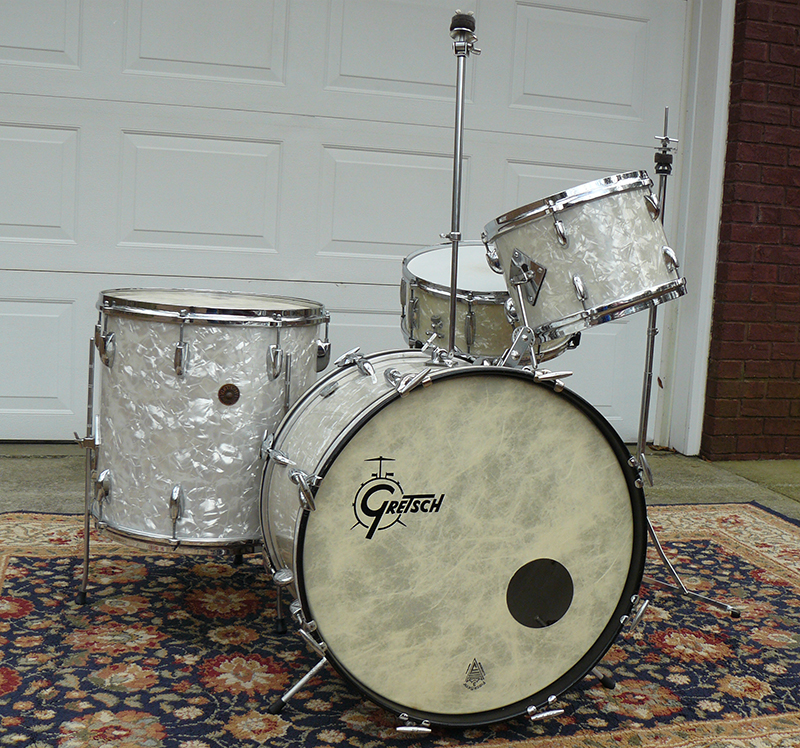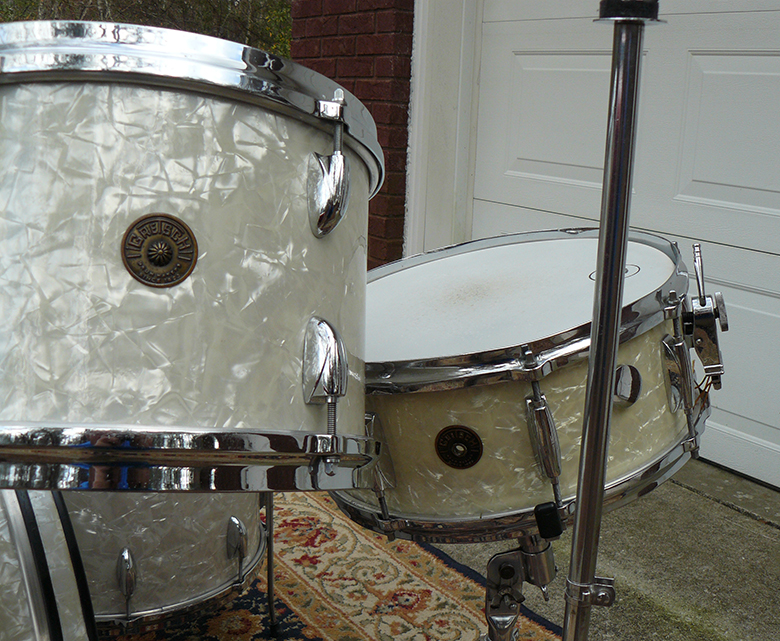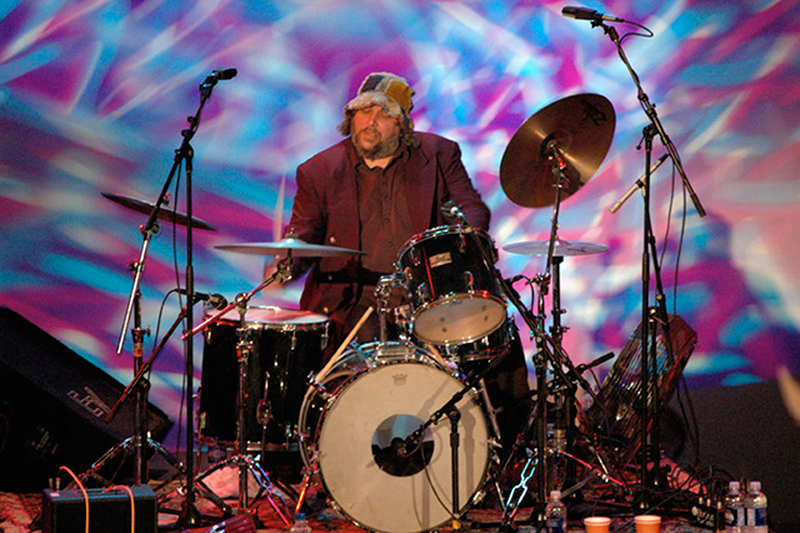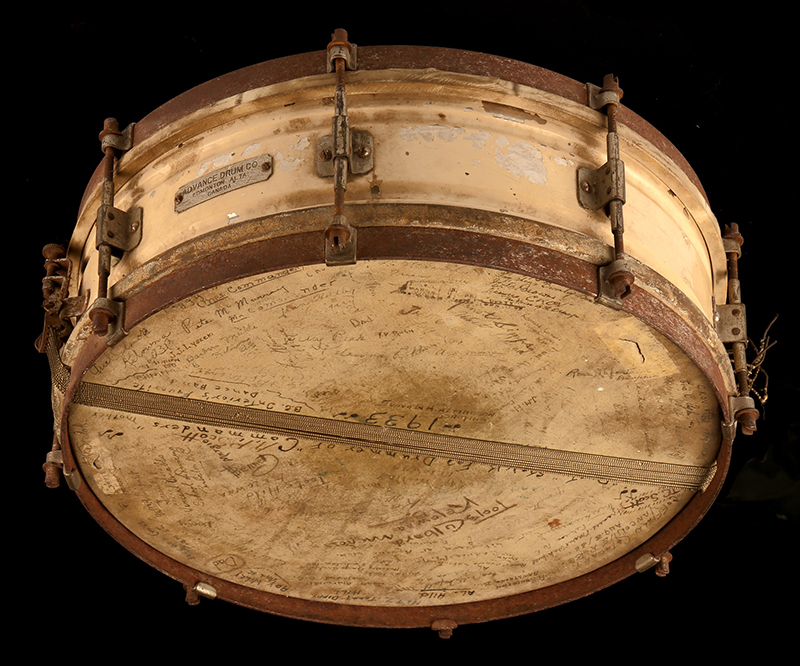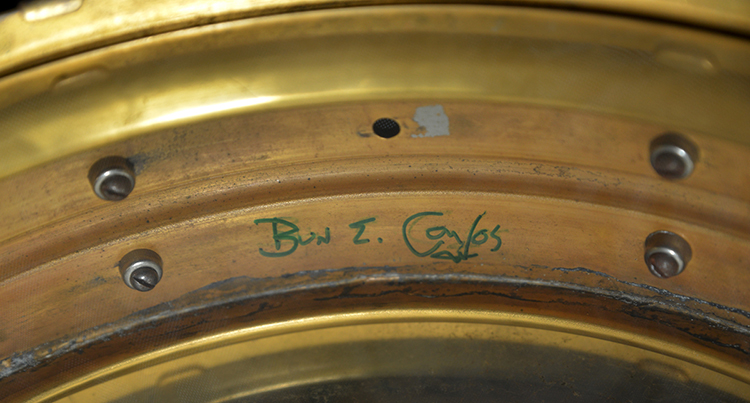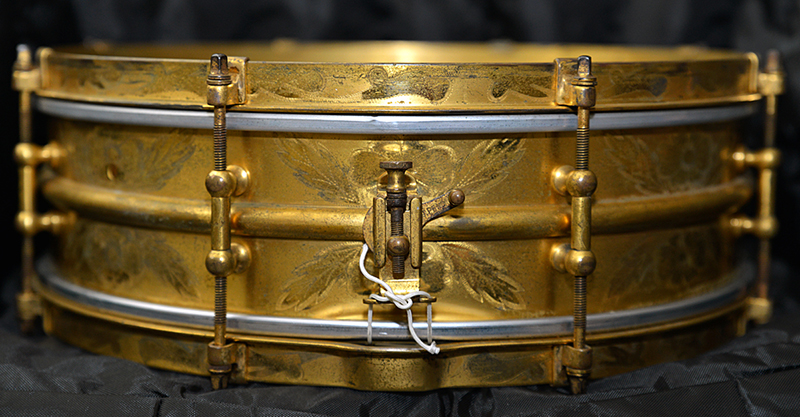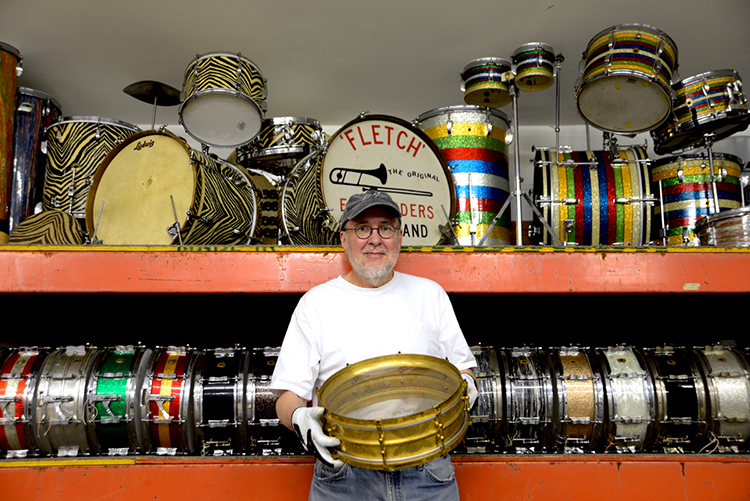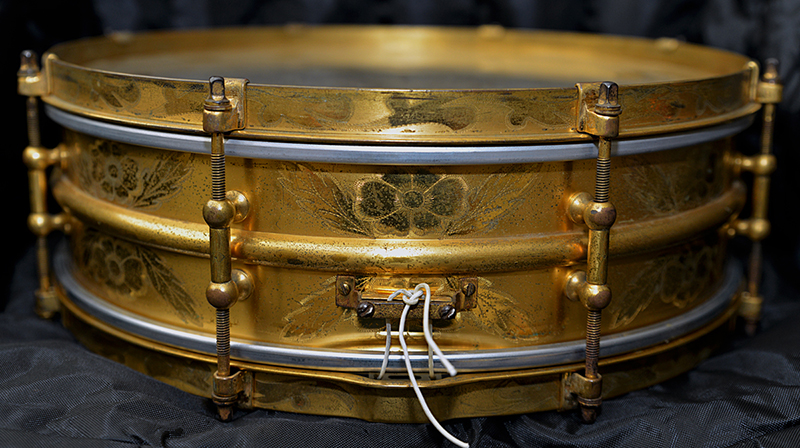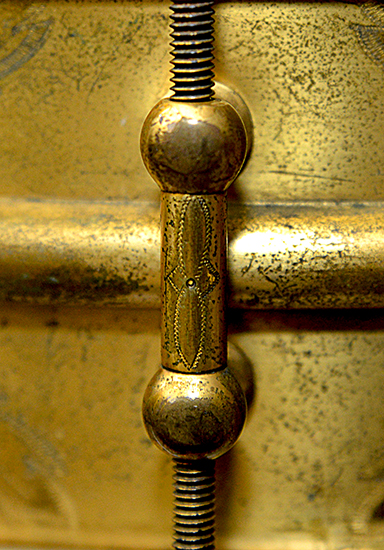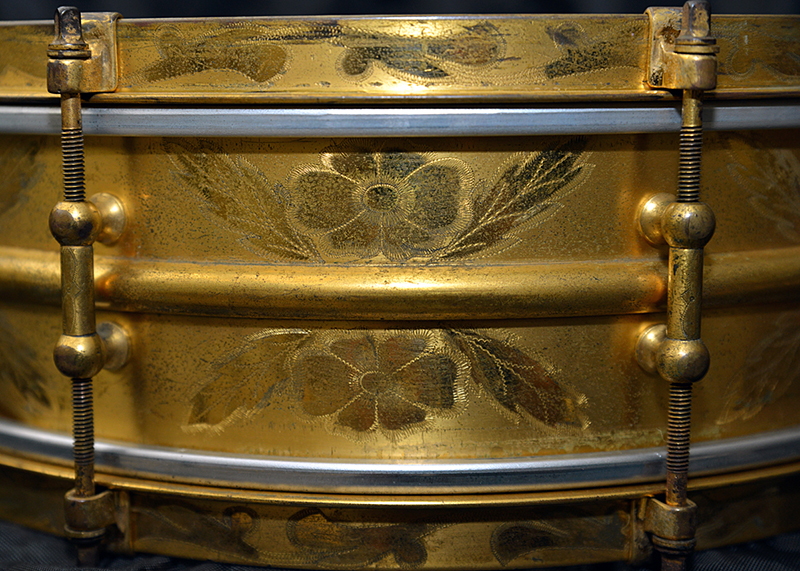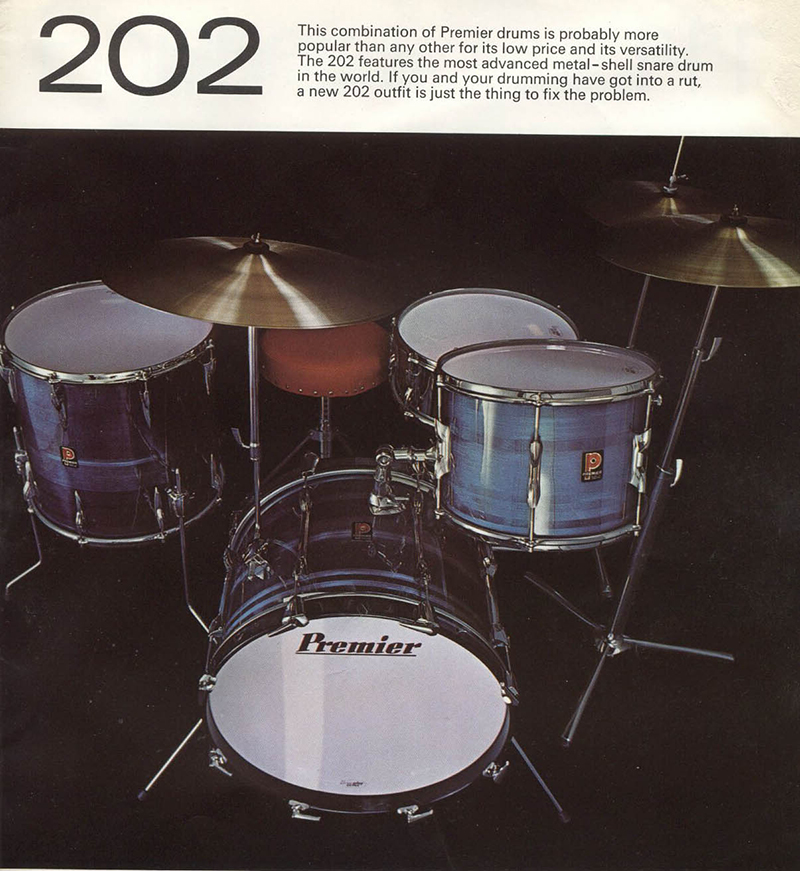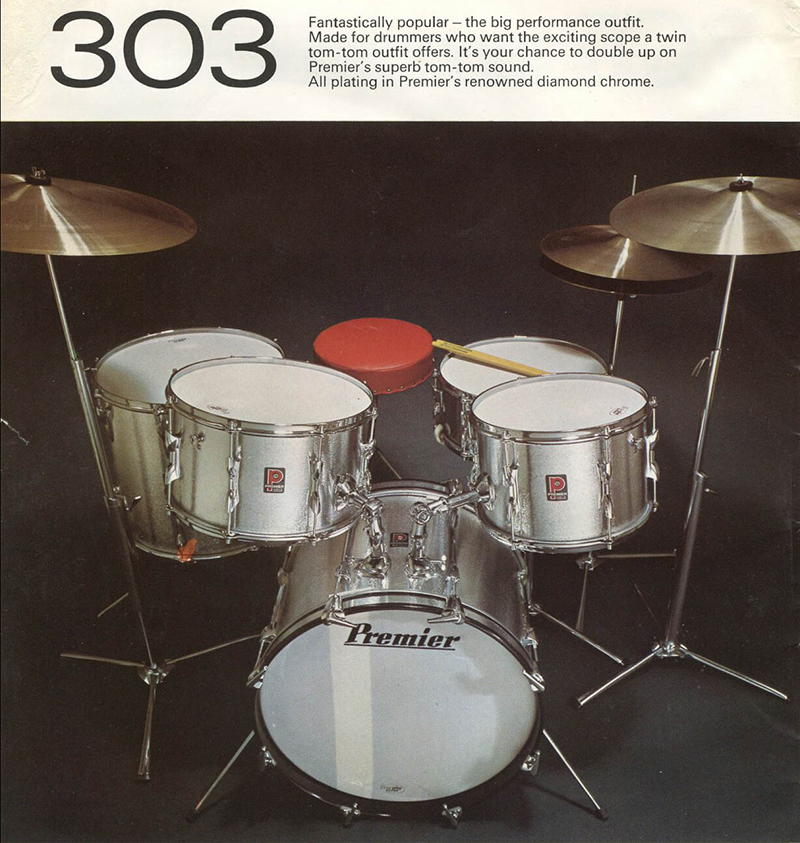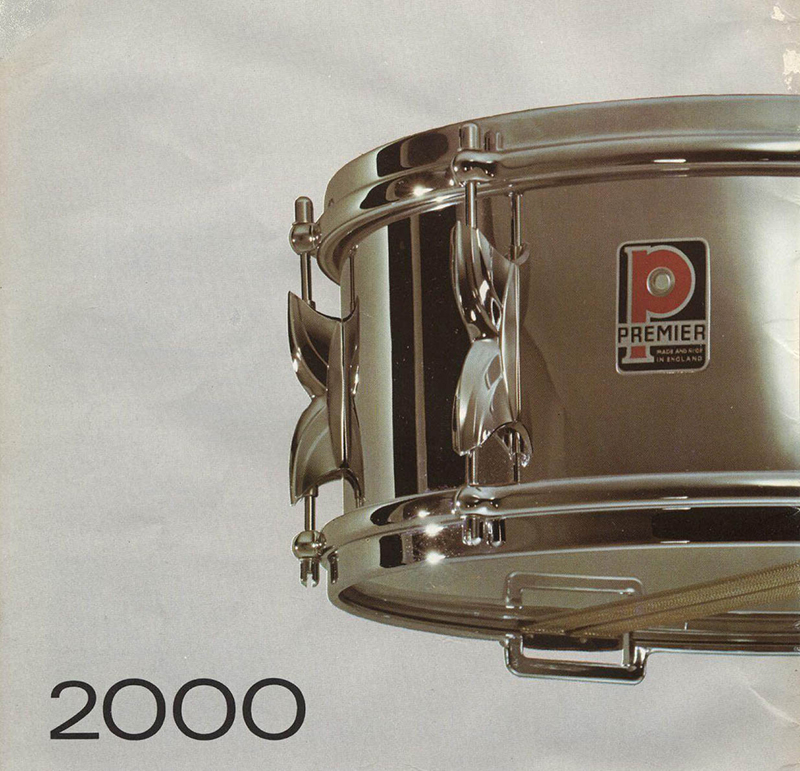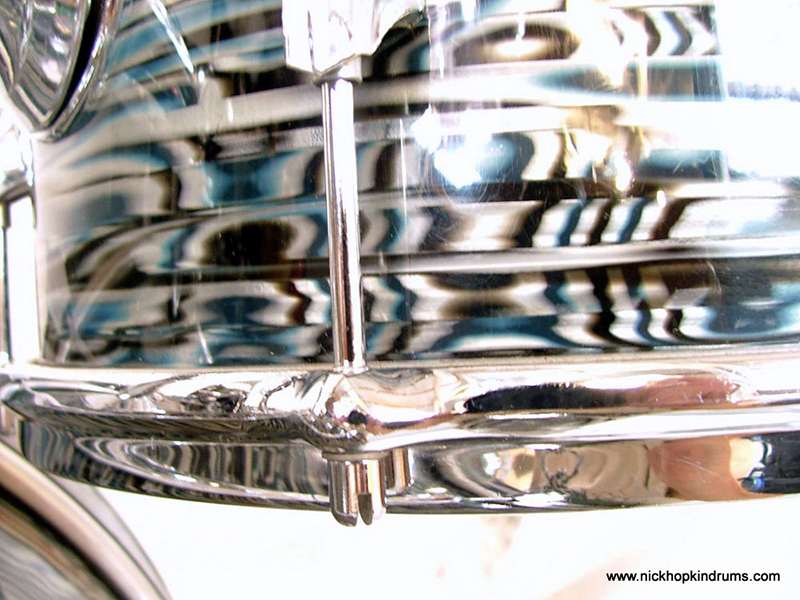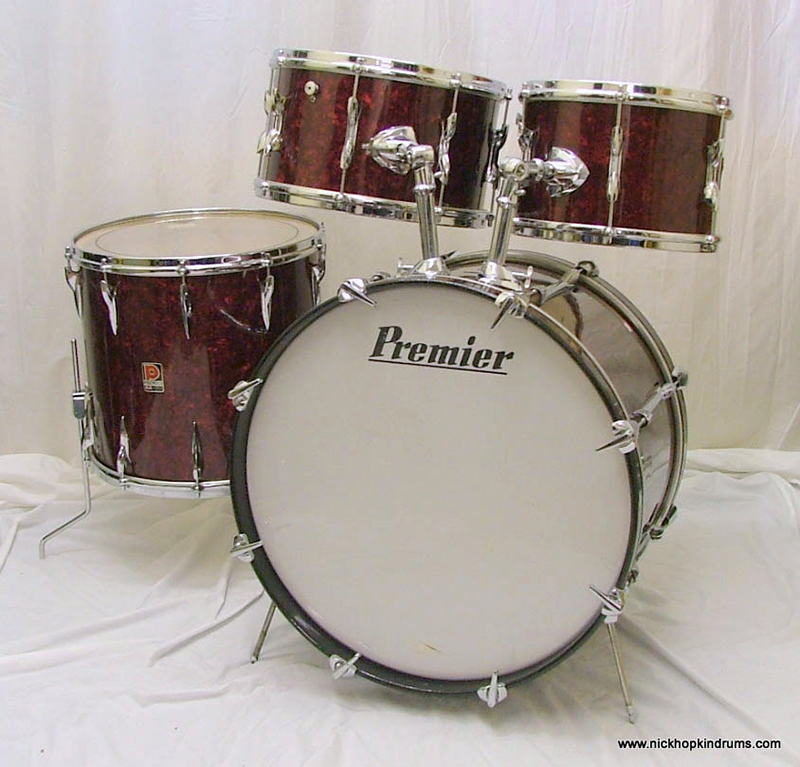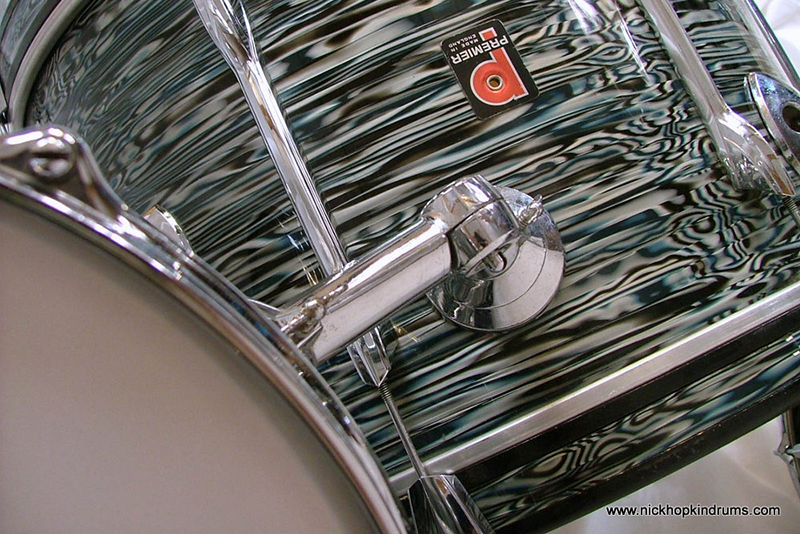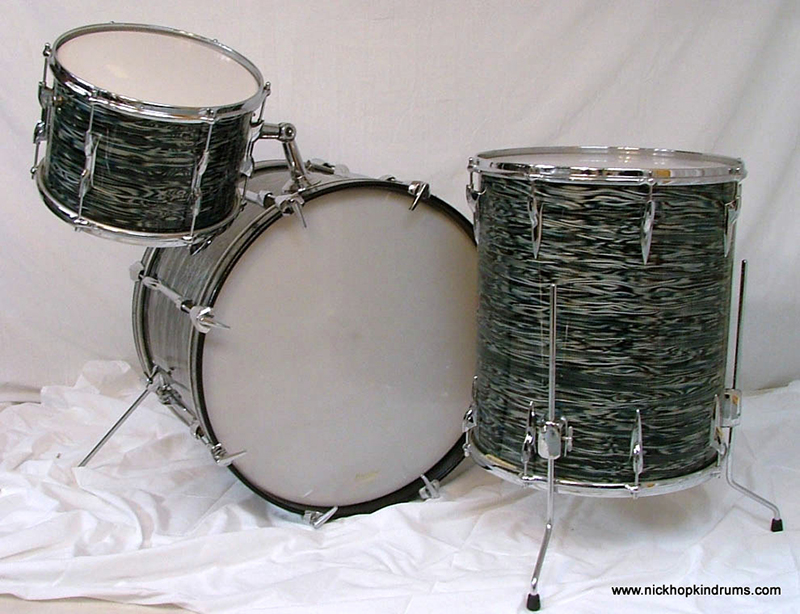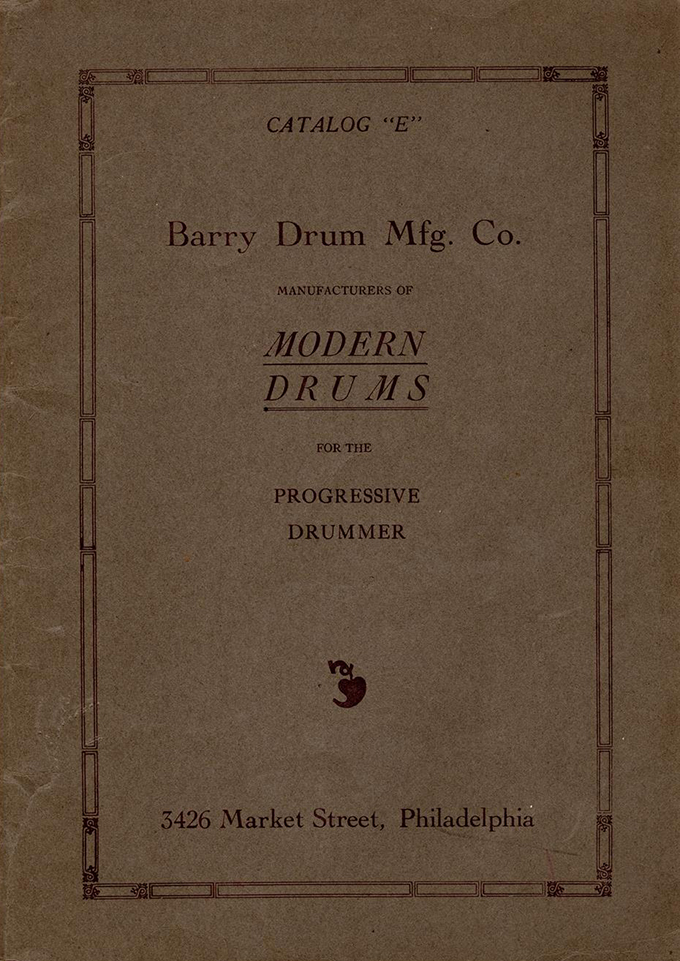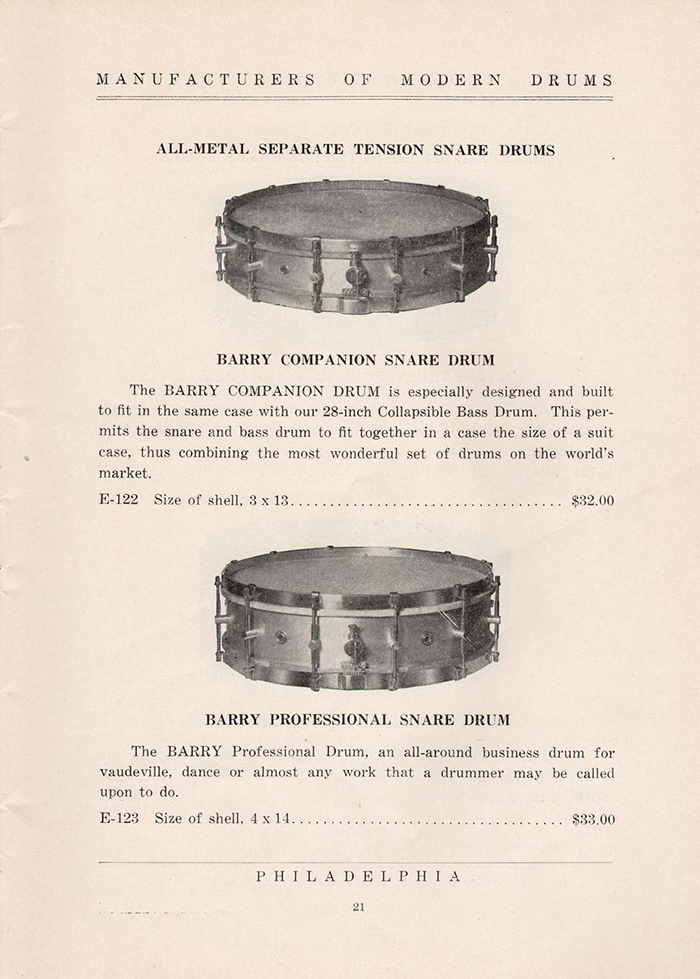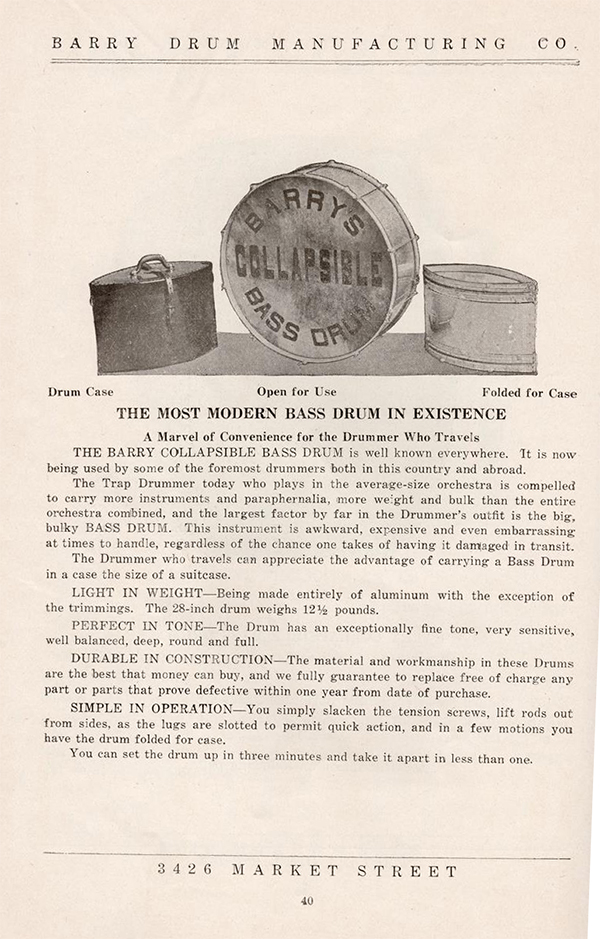I was reading some posts online & George mentioned that you folks found a lacquer that was hard enough to topcoat cymbals. Could you tell me what that lacquer is or can I buy some from you folks for my Paiste Signature Series fast crash? - Stan
Read moreL&L 1920s Brass Oval Badge
Hi George, I was wondering if you might know where I could find a L & L 1920's brass oval badge in nice shape. I've made a few contacts to date and have someone checking for me at the Connecticut and Chicago drum shows, but was hoping through your own contacts, you might be able to point me in a specific direction. Thanks very much for any assistance you can offer and also wanted you to know, NSMD is looking great these days.. nice job!
Best regards, Joe Czulinski
---
Hey Joe, I don't have any in stock, but I'll post your request. Anyone?
Nice 1952 Leedy & Ludwig Kit
From Denzil Woody...
This Leedy and Ludwig kit was purchased in 1952 when I was a sophomore in college. I played them for three years and they have been stored in hard cases since that time.
What Are You, New?
Submitted by Joe Gaskill...
What are you, new? It doesn’t take too long for men of certain tastes to show me their upturned nose. It happens in any sub-sub culture, really – classic cars, baseball statistics, Pokemon. When someone is new and alone, few people want to give you the time of day. Sure, you might get a cursory “welcome to the forum, poonwrangler69”, but the second you confuse a Powertone with a Dynasonic, people tend to ignore you. I’m not coughing up leprosy, here. I’m just new.
Some (embarrassing) history: Right after high school, I got me a job at Guitar Center. And for 14 months, I was that guy. Yeah, I had a side-snare on my zebra-striped DW kit. Yeah, I had suspended floor toms. Yeah, I had a china splash. Two of them. For me, DW made the best drums on the planet – and it wasn’t until years later that I realized that the only thing DW had over other drums was an enormous advertising budget. And boy did I buy into it. Looking back, I think I overpaid.
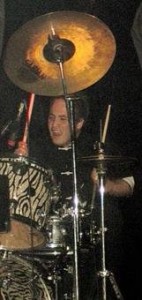 6 years ago, I was sound-checking a drummer’s vintage kit. I dug into him. “Why do you play these? What can these do that a modern company with zillions of dollars in R&D can’t?” His reply wasted no time: “Hit ‘em!”
6 years ago, I was sound-checking a drummer’s vintage kit. I dug into him. “Why do you play these? What can these do that a modern company with zillions of dollars in R&D can’t?” His reply wasted no time: “Hit ‘em!”
And hit ‘em I did. The next week, I sold the Dee-Dubs at an enormous loss and paid too much for a 74 Ludwig Hollywood in peeling Black Diamond Pearl. But that’s all it took – hitting two three-ply floor toms at once shook something deep inside me (besides my lower intestine) – everything I thought I knew about drums was wrong. I was about to start a long, incredibly expensive journey into a world I knew little about – with no one to help me.
I picked up knowledge where I could. After a few embarrassing incidences where I asked questions I could’ve found the answer to on Google, I realized that reading the conversations of other collectors on vintage forums was easier than risking looking stupid. Suffering fools, I've learned, doesn't come easily to collectors of great means.
But I understand. You didn't spend years building a knowledge of minutiae that rivals a sommelier’s just to baby-sit the new kid. Hell, I wouldn't want to talk to me either. (Is it the beard? My mom tells me it looks distinguished!) The reality shows about antiquing and picking and pawn-starring hasn't done much to stem the crimson tide of non-drumming craigslist speculators looking for a quick flip-buck, either. But before you hesitate to answer a Supraphonic question you've heard 1,000 times, try and remember – the more I learn, the bigger my passion for vintage drums grows – and the more I want to spend every free cent I have on them. And you guys always have something for sale.
You using that bit of oyster pink wrap?
1929-1935 Ludwig Super Sensitive
Antone Lourenco of Aantone's Music sent me this one to appraise...
What is this drum worth?
Hey Antone, That is the first model of the Ludwig Super Sensitive snare made between 1929 and 1935. Not to be confused with the first model with a parallel strainer, the Super Ludwig that debuted in 1925. The Super Sensitive has the extra snares under the top head. I'd estimate the value at $2000 if it's in great cosmetic and working condition which it looks like it is. Do you mind if I post this on the Not So Modern Drummer site? Beautiful finish and inlay. Is it for sale?
Well known snare collector Mike Curotto said $1,500 to $2,000.
-George Lawrence
1930 Leedy Red Onyx Snare
Hi all,
I hope that your 2013 Holidays were filled with happiness and joy. Mine were - as I bought myself a snare drum for my birthday, December 23rd. Just the week before, I saw a post/photo on one of the forums that asked a few questions about this drum; so I “cold emailed” the owner, struck a deal and received the drum on my birthday.
There was some competition but my bid sealed the deal. The owner, Jason Dennis, told me that the drum was his grandfather’s and that he had given it to Jason approximately 25 years ago. Here’s Jason’s quote:
“So, I've had the drum for the last 25+ years. My Pap gave it to me. In speaking with my grandmother over the holidays, it turns out he never played. His wife said that he used to do estate clean-outs and that it likely was acquired in this process. In terms of provenance - best I can do: Jason Dennis, Kurvin "Pap" Dennis and that it came from a home in York, PA.”
This drum completes another “set” as you will see later on in this article.
1930 LEEDY 5 x 14 RED ONYX PROFESSIONAL MODEL
The Shell: The Red Onyx wrap was in very good condition and was easy to clean and polish. The wood grommet is perfect, the solid mahogany shell is in round and the interior is very clean. So all in all the shell was a breeze to clean and polish. From my research (thanks Rob Cook) it looks like this finish was only around for one year, 1930.
The Hardware: The nickel hardware was another story. The hardware was very dirty and very clouded so I once again had Les at Avenue Plating do his magic. The procedure is to dip the hardware in the industrial soap tank, clean off the schmutz with a very light brass wheel, “color” (polish) the dull nickel back to life and then a final wipe down to remove any left over rouge. As you can see the hardware is now cleaned and polished but it still looks its age. It looks like the previous owner decided to use 12-24 slotted screws instead of the 12-24 slotted (filister) or 12-24 square tension rods that would have come with this snare drum. Fortunately I had 16 slotted tension rods in my parts stash. The butt plate was pretty thrashed so I also swapped that out for a better one. The Speedway strainer works perfectly and the top rim has a very nice Leedy Indianapolis stamp. One observation here; over the years, having done many cleanings and restorations, I have noticed that Leedy almost always used 6-32 screws on both the Speedway strainer and butt plate whereas L & L used 4-40 screws on their P338 and butt plate.
Of-the-era Leedy Hardwhite batter head, of-the-era slunk and James Snappi Wires rounded out this restoration.
As I mentioned earlier, I was able to complete another “set”. The original Leedy 1929-30 flyers show color photos of Black Onyx, Rainbow Pearl and Red Onyx. I’ve attached a photo of my snare drums in those exact finishes but with one exception...it seems that Leedy also made an un-cataloged Green Onyx finish. The snare drum in the photo is the only example that I have ever seen or heard of in Green Onyx. As always I welcome anyone to weigh in if you have or know of any other Green Onyx drums.
Enjoy! Mike Curotto
Gigging Vintage Drums - Made in Japan
From Wade Francis...
When they hear the words "Made in Japan" most people in the vintage drum world will probably turn their noses up or at least have negative thoughts. For the majority of those people, I cannot blame them. Having been addicted to vintage drum forums for a while now, I've seen first hand the bad name these drums have gotten. I was almost sucked in by the stigma but one road trip and a 1960s Star kit later, I must now defend these kits.
Shortly before purchasing my first vintage kit, I began trawling forums hoping to gain some information on what I was going to get and I have to admit that I almost backed out of buying the kit because of what I found. I was given the impression that "MIJs" were of poor quality and were often referred to as fire wood. Apparently they were notoriously hard to tune and were not durable in the least but after looking at the photo of this particular kit over and over again, it was the nostalgic appearance that won me over. The orange sparkle wrap was very similar to my brothers John Grey Autocrat kit that I learned on when I was around six years old. So I rounded up my cousin and we drove seven hundred twenty five kilometers from Adelaide to Melbourne (Australia) and back which ended up being an eighteen hour round trip so I was really hoping it would be worth it. I wasn't disappointed in the least.
The setup consisted of 20",16", 12" and a 14" snare. I could not believe how big and powerful this kit sounded for its size. The shells were three ply with re-rings and being only a teenager at the time, I was convinced big sounds came from thick maple shells only. How naive of me. I must admit however that the snare was fairly average sounding which I attribute to only having 6 lugs but when tuned quite high, it could still hold its own. Even with the beat up old skins that came with it, this little old kit really sung. I have never bothered replacing the heads on it and I wont until that sound fades. That little 12" tom is still my favorite sounding of all the kits I have ever played and I've played a lot of brands now. So you get the picture - it looked great and sounded great. Next, I decided to make it my gigging kit. After what I had heard about MIJ hardware breaking down after one gig, I was a little nervous - but there had been no bad luck so far so why stop? I gigged almost every week for two years on that kit, not to mention many hours of practice. I only had one hardware issue which was with one tom on a Drum Mate kit.
After acquiring and getting addicted to restoring a few more vintage kits (they are another story), I thought it would be a good time to stop gigging with that first kit and put some work into it . I started using a 1960s Pearl in black diamond pearl wrap for gigs. It sounds great and not a single hardware issue with it.
My point is that these drums are good quality and can hold their own against Ludwig, Slingerland, etc. I am not for a second suggesting they are as good or better than these drums, as my personal favorites are Ludwig, but they definitely are more than capable of a good sound and certainly are not "fire wood". It comes down to knowing how to tune them and, obviously, how you care for your drums. Don't try to tune these the same as you would a maple drum because it's just not going to work. Understand your drum and what its strengths are. With a good polish, these drums look a million bucks and they are considerably cheaper than their American counterparts. There is actually a very good video on youtube that compares an MIJ and a Ludwig set in the same room. If you are skeptical of what I have written, you will be very surprised by the results. http://www.youtube.com/watch?
Is my Ludwig stainless steel 28" bass drum the only one in existence?
Hi George,
I read an article you wrote and thought you would be a good person to ask if you have ever heard of a steel kit like mine.
My 70's Ludwig stainless steel kit appears to fall into the category of "the only one known to exist", because of the kick drum size. My kick drum is a Ludwig factory virgin 14x28 (NOT a marcher converted) and is with it's mates it left the factory with except snare, 12x15 tom, 16x16 fl, 16x18 fl. My 28 kick and 15 tom are consecutive serial numbers. There is no mention of one on the internet.
Rob Cook (Rebeats) has authenticated my kit as a factory grouping of drums so all of the fine details have been scrutinized and it is the real deal. I have owned the kit for over 29 years and have always been on the lookout for another, asking knowledgeable people like yourself if they have ever heard of another. Well no one has ever heard of one, and they are very resistant to believe I have, what I think I have, thus why I had it authenticated by Rob. Unfortunately I am the second owner of the kit which also factored into taking it to Rob.
So, are you aware of any other steel kits Ludwig produced with a 28 kick?
Thank you for your time, Scott
Orlich Glass Snare Drum
From the Orlich website...
Orlich drums use beautiful beveled glass and brush-finished brass to produce an instrument of superb musical intonation.
Since 1989 drummer/glass artist, John Orlich has been crafting the actual glass drum. The drums are outstanding musical instruments. In addition they are quite collectible works of art and are financial investments. Each drum is handmade, signed and numbered. Stock sizes will accommodate most drummers’ needs, though drums of custom size can be built to order. Orlich also offers special personalized touches such as glass etching and custom patinas.
Orlich drums will not break from musical use. Though made of glass and perhaps requiring a little more handling finesse, the drums are quite tough due to the superstructure of brass which holds components together. Unless your roadie or drum tech is a complete gorilla you should not fear this material.
http://orlichactualglassdrums.blogspot.com/
January 2014 - Happy New Year!
Happy New Year... now get back to work!
The date and location of the 2014 Nashville Drum Show has been confirmed. The dates are September 20 and 21. The venue is the Global Mall Event Center in Antioch, a suburb of Nashville. More details to follow. Keep an eye on nashvilledrumshow.com. We are accepting reservations for exhibitor booths and for advanced tickets. Please email info@nashvilledrumshow.com for more information.
Announcing a new event at the Drum Room, our Not So Modern Drummer headquarters here in Nashville TN. We are hosting the Nashville Drummers Swap Meet, Wednesday, January 8, from 1 until 8 pm. Attendance capacity is limited so we are not publishing the address, so if you are not a member of the professional Nashville Drummers Facebook Group and would like to attend please drop us a line - george@georgesdrumshop.com. There is no admission, no booth fees, and no fees of any kind. It is a completely free event. What goes on at a drum swap meet? Buying, selling, trading of used drum gear and other musical gear, refreshments will be served, and a lot of drummer camaraderie will ensue.
In this issue, for your viewing pleasure, are more beautiful vintage and custom drums and a review of an unusual drum set made by Bello. I am also excited to welcome aboard two new writers who are well known in the vintage and custom drum world.
Robert Campbell, who has a serious collection of rare and collectable snare drums, shares with us the story of his Ludwig & Ludwig 1928 Gold Triumphal Snare Drum with engraved Wild Rose pattern, a rare bird indeed. The story involves Steve Maxwell, Bun E. Carlos and cites Mike Currotto and John Aldridge.
Our other new writer, Nick Hopkins, owner of Nick Hopkins Drums, a vintage drum shop in the U.K. Nick’s first article is about Premier drums from the seventies era. Thanks, Nick, we have needed an English correspondent.
Ronn Dunnett, well known drumsmith and owner of Dunnett Classic Drums and George Way Drums contributed a beautiful picture of one of George Way’s early instruments.
Also several great contributions from readers and press releases from the drum industry in the popular “Whatcha Got?” section.
Thanks for reading and remember, the drummer with the prettiest drum set gets the gig!
George's Signature
(330) 338-6035 george@notsomoderndrummer.com
Bello's Fiberglass Fusion Kit
The Bello Drum Company is the brain child of Bill Haller. In his small workshop in Greenville Pennsylvania, Bill constructs the fiberglass drum shells by hand. Fiberglass drums have been around for five decades and have withstood the test of time, even though they don’t have a large market share. Bello drums are a niche boutique item. All drums are built to order with a good number of color and size options.
The set that Bello sent us to review is called a fusion kit in their price list. The sizes 12 x 20 bass drum. 10 x 9 small tom, 14 x 14 floor tom, and a 13 x 6.5 snare drum in a beautiful purple finish. I would normally call this a “compact kit”, but, upon playing them the small sizes belie the large sound so there is no compromising of tone for the convenient sizes. All the drums had a very nice square badge secured with four small screws. The lugs are pretty standard rounded lugs that give the drum a nice look. Hoops are all 2.3 mm.
The bass drum came with gull wing spurs which fold nicely into the curve of the shell. I’ve always had a soft spot in my heart for shallow bass drums, so I really looked forward to giving this one a test run. The 12” depth makes for a short, quick response. The drum was fitted with an Aquarian clear batter head with built in ring and the front head was a a black Attack Terry Bozzio single ply with port. The wood bass hoops had a nice glossy clear finish and were a nice color contrast with the purple shells. I tried the drum with and without muffling . When muffled, the drum had a nice punchy thump with good low end. Without muffling the same qualities remained, plus a nice sustained low note from the front head. I tried two tunings; a loose medium low and a high jazz-ish tuning. No problem in the tuning range department. Fibreglass drums have always been known for their volume and this bass drum is no exception.
Toms. The toms had a rich, fat, clear, musical sound with a nice sustain. Very warm. The heads were Aquarian coated single ply on top and Attack Terry Bozzio clear single ply on bottom. Both toms had a good long sustain and a wide tuning range. The mounted tom comes with a RIMS holder and bracket for an L arm, but no tom arm or bass drum mounting bracket were included.
The 13” snare drum was very responsive with a nice dry spot in the middle of the head and a nice ringing when played near the hoop. The snare beds were shaped correctly so it has a nice snare response. The throw off is a Taye type lever – a simple throw off. The drum tuned well at low and high tunings. The low tuning with a zero ring sounded especially fat.
All in all, this Bello kit is a very balanced set of drums. This would be a very nice versatile kit that could be used for small jazz and coffeehouse gigs as well as louder pop/rock gigs where a punchy sound is required.
Because of the fiberglass shells and shell hardware that is on the small side, the drums are very light weight. Fibreglass is also very durable and impervious to extreme tempatures and moisture. The 12” long bass drum makes the footprint of the set smaller than your average rock kit, facilitating set up on tight stages.
Bill Haller is making some nice instruments. Give Bill a call or send him an email if you want to find out more. He’s a very hands-on, amiable guy with a great off kilter sense of humor. He can be reached through the Bello website – www.bellodrums.com.
Enter the Bloody Wheatfield
Maker: Charles E. TownCirca: 1853-1859 Dimensions: 14.5”(h) x 16”(dia.)
The ground must certainly still have been soaked from the recent rain as a young 16 year old named John H. Rosensteel ventured out from his home in the vicinity of the Round Tops south of Gettysburg. Along with many other local residents, he was there to start the gruesome task of burying the dead. It was Sunday, July 5th 1863. The Confederate Army had quit the field late the day before. They started the long journey back to Virginia during the night in a drenching downpour that had washed away the blood but could not hide the destruction of three days of savage fighting. John’s home had become part of a nightmarish scene caused by the destructive power of over 170,000 battling soldiers. One of the first of the dead that he encountered was a young Confederate soldier about his own age.
John picked up the gun lying beside him and decided to keep it as a souvenir. This gun was the first piece of what would become the famed Rosensteel Collection; a collection that would become the family’s legacy and would eventually number well over 43,000 pieces.
As John continued to collect the debris of the battlefield, he eventually came across an abandoned eagle drum somewhere in the vicinity of the Wheatfield and back toward Little Round Top. The drum belonged to one of the drummers of the U.S. Regular Army. The Fifth Army Corps had within its ranks of the 2nd Division two brigades of U.S. Regular Army Infantry battalions commanded by General Romeyn B. Ayres, which were brought up in support of General Daniel Sickles Third Corps line. The Third Corps was being pummeled by Longstreet’s sledgehammer attacks during the evening of the second day. Ayers two brigades of U.S. Infantry Regulars contained elements of the 2nd, 3rd, 4th, 6th, 7th, 10th, 11th, 12th, 14th, and 17th Regiments. These two brigades were commanded by Col. Hannibal Day and Col. Sidney Burbank.
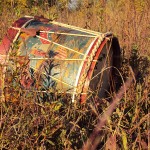 Around 5:00 p.m. on July 2nd, the two brigades crossed Plum Run in an area of what would soon become known as the Valley of Death, moving west to the crest of a rocky wooded ridge, and then advanced through the woods to the edge of the Wheat Field. They initially took position behind a low stone wall, just as units from the U. S. Second Corps were being pushed out with heavy losses. The U.S. Regulars then entered the fray and engaged the veteran legions of Confederate General Wofford’s Georgia Brigade. Both sides suffered frightening losses, but it was the Regulars who took the brunt of it, suffering 50% casualties. Their exodus was no rout; the Regulars marched from the field in good order taking heavy losses, turning to fire at the Georgians as they were pushed back over rough terrain to the Little Round Top line. Sometime during this encounter with the enemy this drum was lost for some unknown reason, only to be picked up a few days later and added to what would become the largest private collection of Gettysburg relics.
Around 5:00 p.m. on July 2nd, the two brigades crossed Plum Run in an area of what would soon become known as the Valley of Death, moving west to the crest of a rocky wooded ridge, and then advanced through the woods to the edge of the Wheat Field. They initially took position behind a low stone wall, just as units from the U. S. Second Corps were being pushed out with heavy losses. The U.S. Regulars then entered the fray and engaged the veteran legions of Confederate General Wofford’s Georgia Brigade. Both sides suffered frightening losses, but it was the Regulars who took the brunt of it, suffering 50% casualties. Their exodus was no rout; the Regulars marched from the field in good order taking heavy losses, turning to fire at the Georgians as they were pushed back over rough terrain to the Little Round Top line. Sometime during this encounter with the enemy this drum was lost for some unknown reason, only to be picked up a few days later and added to what would become the largest private collection of Gettysburg relics.
Ten years before this bloody exchange, Charles E. Town of Bath Maine, received the first of two contracts during the 1850s to make drums for the United States Army. The contract of 1853 was for 100 drums for the Infantry. Then in 1859 he received a second contract for 19 drums for the Artillery and an additional 56 drums for the Infantry. This drum is one of the 156 drums Town made for the U. S. Infantry during the 1850s. Inside the drum, opposite the vent hole, is a paper maker’s label in very good condition which simply states: “DRUMS / Made and Sold by / Charles E. Town, / Bath, Maine.”
Sitting on the blue field for infantry is a primitive, hand painted version of the United States Arms…..sometimes known for the central figure as an “eagle” or “eagle drum.” In comparing this version of the Arms with other known Town drums, it seems quite plausible that Town used a stencil for the outline and had the rest hand painted by a skilled painter. The style of the Arms certainly dates this drum to the 1850s.
The shell is made of a single ply of ash wood which retains much of the original stain and varnish. Town reinforced the seam, formed by a scarf joint, with his own unique brass tack pattern of a rectangle with a vertical diamond-circle-diamond within and centered on the unreinforced vent hole. The maple counter hoops also retain much of the original red sponged paint. Interestingly, there are severe water stains on the back portion of the shell that give evidence of the acrid nature of the rain that fell on the 4th of July as this drum sat quietly where it fell on the field only days prior to its retrieval by Rosensteel. There is no evidence that this drum ever had a mechanical snare adjuster mounted to it; the snares were simply run between the head and the lower counter hoop and pulled by hand to increase the tension.
Since this drum was in very good overall condition, it was decided to make it a player. With the addition of new gut snares and a leather snare butt, one leather rope washer and a metal ring secured by a black leather lace to attach to a drum sling, only a light cleaning was in order. The drum had been partially restored some years prior by an able, unidentified person who installed new skins, 10 leather ears and linen rope.
This drum has an enormous sound that carries the distance when tensioned up and played with the proper sticks - obviously heard above the din and roar of battle.
In 1888, John Rosensteel started the Round Top Museum in honor of the 25th Anniversary of the Battle. John eventually passed custody of his collection to his nephew, George Rosensteel, who also remained dedicated to educating the public about the epic battle. After the 50th Anniversary of 1913, George expanded with the National Museum. By 1921 he had moved it all to the location of what would become the now former National Parks Service Visitor Center and Museum, located across the road from the Cemetery. Within this building which was built on the premises of the old Gettysburg town dump, the Rosensteel family lived and housed the museum containing the huge collection, which was open to the public. It was George’s son, Joseph Rosensteel, who created the famous Gettysburg Electric Map in 1938, which used small light bulbs to show the flow of troops during the three day battle. Joseph died the following year from cancer.
In 1971, the Rosensteel family sold the property to the National Park Service for $2.6 million. The bulk of the artifact collection was given to the “people of the United States.” Touring the Visitor Center’s Museum at Gettysburg, one can see the core of the old “Rosensteel Collection!” However, the Rosensteels did retain a portion of the collection they deemed as “special.” This drum was one of those “special” pieces held by Larry and Angi Rosensteel Eckert, George’s daughter. The Eckerts passed the drum to friend and collector John Fenstermacher, Esq. and his wife Peggy for legal services he performed for them while working with the National Parks Service. With Johns passing, Peggy sold the drum to the Hill Collection.
With the history of this drum’s incredible collection status and the events leading up to the Battle and its retrieval from the southern end of the Gettysburg Battlefield, the details surrounding this drum are epic and monumental to say the least. The shell still bears testimony to this with the numerous scars that are visible. The identity and ultimate fate of the anonymous lad who carried it on to a field which changed hands six times in a matter of only a few hours will remain unknown. It was a field so violent that it transformed into a “whirlpool of death.” One veteran of the battle later remarked of the U.S. Regulars who fought in the Bloody Wheatfield, “for two years they showed us how to act like soldiers... at Gettysburg, they showed us how to die like soldiers.”
From Lancaster County, PA... thoughts from the shop.
Brian Hill brisoundperc@yahoo.com
Phil Wilson's 1950s Gretsch Set
Greetings vintage drum lovers,
Old man winter has finally made it. It's probably cold where you are and probably you are getting some of the "white" stuff around your home or business. Being from Georgia, we hardly ever get snow, but I like "white" drums falling into my lap.
I bought this wonderful white pearl 1950s Gretsch set a while back from a man who brought them right to my door from New York. I'll tell you more about how I was lucky enough to get them after I describe them.
I believe this set is from the late 1950s because I have been studying up on them in "The Gretsch Drum Book" by Rob Cook and John Sheridan. If you don't have this book you need it. It is a great source of information about everything Gretsch. The shells are heavy three ply with silver sealer inside that dates them in the late 1950s. There are no orange labels inside that started in the early 1960s. The round badges were used from the 1930s through the 1960s. These "round badge" Gretsch drums are very collectible. They are also great sounding drums. The sizes of these drums are bass 20"X14", the ride tom is 12"X8", the floor tom is "16X16". The matching snare is 14"X5". The snare has the Micro-Sensitive strainer. There is a diamond plate cymbal mount on the top center of the bass drum. The distinctively Gretsch bass drum T-rods have been used since 1958. Another cool feature is the long lip extension rod to raise the tom tom.
One good thing about having my name out there as a collector is I get calls when someone wants to sell a vintage drum set. I can't buy them all, but I try to give advice to everyone who calls or E-mails me. A man from New York E-mailed me to try to get some advice about this drum set. He had no idea they were valuable. He had listed them on Craig's list trying to trade them for a Kayak. He said he had twenty responses all wanting to buy him a Kayak and get these drums. He ask me if I wanted to buy them. He told me I was his second call. He had already called a very well known drum seller. This drum seller is a friend of mine, and he had given him a dollar amount that he felt they were worth. I ask him if my friend had offered to give him that much. He said well,no, but he said "that's what they are worth." I said," they are only worth what someone will give you for them." He laughed and asked if I would like to see them. He said that he and his family rode right by my town going to Florida for vacation, and he would bring them if I wanted them.
I was very excited when he arrived at my door and we unloaded this set. It was very dirty and needed a lot of love and attention, but I could tell it was a very desirable set. I made him an offer of cash and he accepted it. He said,"I have another old drum I want to give you". He reached under the seat and pulled out a 1960s Keystone badge Ludwig Supersensitive. It was in excellent condition. That was just a bonus to the deal. I was smiling when he left.
Every now and then do a roll, Phil Wilson
Remembering Tom Ardolino
NRBQ (New Rhythm and Blues Quartet) drummer Tom Ardolino passed away on January 6, 2012 of complications from diabetes at the age of 56. It has been two years, yet his unmistakably distinctive style will live on forever. Tommy helped define NRBQ’s sound with impeccable taste and timing for well over thirty years. He could easily play anything from the ‘Q’s extensive repertoire of tunes, and was the perfect drummer for the band. He had an encyclopedic knowledge of American music, with much of it drawn from his own world-class record collection.
“ There’s Charlie Watts, and there’s Tom Ardolino,” Bonnie Raitt once told the Boston Globe. “That’s it.” Mr. Ardolino “deserves an entire wing in the Rock and Roll Hall Of Fame.”
Sadly, Tommy’s death should be a serious wake-‐up call. NRBQ’s induction into the Rock and Roll Hall of Fame is long overdue. The core group of Terry Adams, Al Anderson, Joey Spampinato and Tom Ardolino have been referred to as the ‘American Beatles’. Some of their many fans include; Bob Dylan, Sir Paul McCartney, Bonnie Raitt, Keith Richards, and Elvis Costello.
Costello once told Rolling Stone, “I’d much rather any day go see NRBQ playing than any of our illustrious punk bands in England.”
Tommy joined NRBQ in 1974 when original drummer Tom Staley departed. He subsequently recorded 15 studio albums and toured the world with them numerous times. Everything about him was instantly recognizable. His fans loved the passion and exuberance of the group. His self-‐taught drumming style was original, and totally his own. He was a rare combination of talent, personality, and loved all things music. Watching him play live was a sight to behold. His rockin’ out on “It’s A Wild Weekend”, “Green Lights” and “Me And The Boys” was amazing.
Former NRBQ guitarist Al Anderson said this about Tom Ardolino:
"He was a great drummer and a great guy, "He had a totally unique style of drumming that nobody can ever duplicate. That was one of the baddest rhythm sections in the world."
Once again, one of America’s all–time greatest bands are still not enshrined in The Rock And Roll Hall Of Fame. It makes no logical sense, and is a sad commentary on the entire music industry. Mainstream musical success should not determine greatness. The original NRBQ made great music which will ultimately stand the test of time. The ‘Q’ were completely spontaneous on stage, never working from a set list. Their many performances over the years were legendary, upwards of 250 shows a year.
Founded in 1967, The New Rhythm and Blues Quartet released their first record on the Columbia label. In 1969, the legendary Carl Perkins and NRBQ collaborated for a second album titled “Boppin’ The Blues”. From these storied beginnings, the “Q” as they are affectionately known, began carving out their long musical legacy. They have a trademark sound like no other, and a unique blend of multiple styles that can be only be defined as truly American. After a short hiatus, and some new members, NRBQ are still together, and their sound is unmistakable. It is impossible to confuse them with any other band in the world, NRBQ never sold out; they didn’t change musical directions to fit the trends, or compromised their integrity for profit. Once again, Tom Ardolino and NRBQ were not among the Hall Of Fame inductees this year. I’ll always keep wondering “WHY”.
Photo Credit : Lili Chilson
NRBQ Website NRBQ Headquarters
Ronn Dunnett's Early 1900s Advance Drum Company Snare
A very special treat for everyone today... I know of only 4 examples of this particular snare drum and I have only actually SEEN one - mine - before this one landed on my bench. The other two are reported to be in the hands of Joe Montinerri and Johnny Craviotto (however Johnny says his may have been lost or stolen). This is an Advance Drum Company snare drum. The Advance Drum Company is the first Canadian drum company ever and was started by George Way in Edmonton, Alberta in the early 1900s.
George Way was responsible for a substantial number of inventions that remain in use on modern drums. Way invented the swivel / self-aligning lug and the first parallel action throw off. He was the first to ever wrap a drum in a pearl finish. He also introduced the China cymbal (what he called the "Chinese Sneeze" cymbal.
I'm not sure if this drum was painted at the Advance factory or if it was painted afterward. Either way, as you can tell by the head it has been around for a very long time - through 2 world wars and a lot more.
The owner brought this to me and asked me to make it playable. I agreed to do this, but with the understanding that I would not remove any of the patina. It is an amazing piece of drum history and while I look forward to hearing it I will do my utmost to maintain the integrity of the drum as you see it here.
-Ronn Dunnett www.dunnett.com
Bob Campbell's 1920s Ludwig & Ludwig Wild Rose Triumphal
The Robert M. Campbell Collection - “1920’s Ludwig & Ludwig 4 X 14” Wild Rose pattern engraved, gold-plated Triumphal, Standard Model” - by Robert “Bob” Campbell
As a collector, there are those “holy grail” or “desert island” snares that you hope one day to find, and with some good luck and sufficient cash, possibly own. At the 2013 Chicago Drum Show, I had the good fortune to be seated next to Bun E. Carlos during the filming of a Vintage Drums Talk segment by Jim Messina, www.vintagedrumstalk.com, www.youtube.com/watch?v=YrOuznVG2ZU). I’m not sure how the conversation started but Bun E. began telling me some stories about the legendary Charlie Donnelly (Connecticut drum store owner and vintage drum expert who Steve Maxwell credits as “the person responsible for jump-starting me down the path of vintage drums.”) This progressed to talk of our collections. I mentioned that I had purchased a Ludwig 1928 Gold Triumphal 100th Anniversary Reissue from Steve Maxwell. However, I said, “I really wanted an original 1920’s Ludwig & Ludwig Triumphal.”
To my surprise, Bun E. said something like, “I have one that I might sell. Are you seriously interested?” I, of course, replied with a most eloquent answer, “Umm, really?” So then and there, we made a deal.
Bun E. kindly invited me to pick up the drum at his storage barn. His amazing, expansive collection is a story for another time but I did get the Triumphal, signed by Bun E. on the inside of the shell.
I was very curious about the history of the drum and asked Bun E. for some background information. He referred me to Steve Maxwell, who originally acquired this Ludwig & Ludwig Triumphal. Steve said the fellow who had the drum obtained it in Chicago from his teacher in the 1950’s. He didn’t play it much then because it was “so nice”. When the seller contacted Steve, he hadn't played in 20 years and wanted to see how much it was worth. Steve provided this interesting account of how this unique, historic drum serendipitously came into his shop:
“I get a call out of the blue from a guy who says he has a metal Ludwig rare drum and since he's in his 70s and living on social security he figures he might as well try to sell it and see if it's worth a few dollars. I asked him to describe it and he told me it was a 1920’s Ludwig. He thinks it's a 5", then again maybe a 4x14”; and he said it was engraved. So, I assume he's talking about a regular Black Beauty, so I ask if the shell is black with engraving showing through, and he says, "No, it's a gold color". So, now I figure that he's got a stripped shell that was originally an engraved black beauty since we see that sort of thing from time to time, and therefore value is a lot lower. So, I ask him about the engraving pattern and if it is floral (and I describe the typical 10-point and 12-point floral) and he says "no". So I describe the typical scroll pattern and again he says "no". So I ask him what the pattern looks like and he says, "it's sort of like a flower". Now, the LAST thing I am thinking is that this might be another Wild Rose pattern Triumphal. I simply figure that he has a 1920’s era Standard that may have been nickel over brass, non-engraved; and I figure someone stripped it, polished the shell, and did a home-made engraving job. So, I tell the fellow to bring it in and I'll have a look. In the back of my mind, I'm thinking that this is maybe a $500-$700 player's drum. However, I didn't say that because I didn't want to disappoint him. So I figured I should just keep quiet until I actually saw the drum.
About a week later, he comes into my store with a drum case. I opened the case and just about passed out on the spot! Looking up from the case was an absolutely incredible 4x14” 1920’s era Wild Rose pattern Ludwig Triumphal. I told the guy to sit down because we had to have a serious talk here...
I pulled out Mike Curotto's book (Vintage Snare Drums: The Curotto Collection, Volume I) and turned to the page where Mike describes his Wild Rose, the only one that ever surfaced. I tell the guy that his drum is now only the second one in this pattern that has surfaced, and in fact is now the 8th Triumphal since only 7 other examples overall are known to exist.
As I mentioned in an email to Bun E, I could have bought this drum from the guy for a song since he needed cash, but I encouraged him to let me broker it on consignment so that he'd get a significantly higher amount than if I were to buy it outright. I told him that I felt we could move the drum fairly quickly for him. Then I told him what I thought we could get for the drum, and he almost passed out! He agreed to consignment so I then contacted Bun E and a few other people who I knew would be interested. Bun E grabbed it immediately. I delivered it to him in person, and the rest is history. It was a nice deal all around because the transaction was really life changing for the seller, and the drum went to someone who appreciated it (Bun E.), and now it's in your hands, which is great.” Many thanks to Steve for providing this wonderful story… Now if I could only find out who was the original owner prior to the 1950’s!
I am an avid believer that our drum history needs to be preserved and handed down to the next generation before it is lost forever. I am merely the custodian of this drum until it passes to the next owner. While I could not get the exact provenance of this Triumphal, I have captured all that I know in this article. If anyone has any information about the origins of this drum (or questions), please feel free to contact me at fallendrummer@me.com.
Brief background on the Ludwig and Ludwig Triumphal snare drum:
The Ludwig & Ludwig Triumphal snare drums were truly exceptional in their day, coincidentally only a few years before the great Stock Market crash of 1929 (e.g., 1925-1928). They were the pinnacle of drum making; gold-plated and ornately hand-engraved on the shell, hoops and even the lugs. My drum is indeed a 4 X14”, 8-lug gold-plated, engraved Ludwig & Ludwig Triumphal Standard Model with the Wild Rose pattern. The center-beaded, two-piece soldered shell is quite heavy for a 4 X14” (although I guess not atypical for brass shell drums of the period). As noted by John Aldridge in his “Guide to Vintage Drums”, the Triumphal like Black Beauties of the period had an air chamber inside the bearing edge, i.e., formed by bending back the last ½ inch of bearing edge at a 90 degree angle and soldering it to the shell. Upon close inspection, I did not find a weld so assume this is a spun brass shell. To date, it is only the second known to exist with the Wild Rose pattern and perhaps only 1 of 8 total Triumphals that have survived.
Acknowledgements: Many thanks to Steve Maxwell, Bun E. Carlos and Mike Curotto for all the input, encouragement and shared wisdom.
Matt Walker Joins Taye Drums
Taye Drums is excited to announce the addition of Matt Walker, drummer for Morrissey to their artist roster. Matt will be using the StudioMaple series for recording and the ParaSonic series for touring.
For more information please contact Taye Drums at info@tayedrums.com or online at www.tayedrums.com.
1970s Premier Vintage Drums
In this and future articles, I’m looking at classic English vintage drums. There is a wealth of knowledge on American drums out there, but I find it difficult to find detailed information on even some of the most popular English drums. So here I’m just sharing observations on drums that come through my shop, supported by information in the original catalogues and other information I’ve come across. So let’s kick things off with the most famous English brand of drums, Premier, focusing on sets from the early 70s.
The few models from this period really marked a progression from the 1960s drums, in both sound and style. Sets from this period were given numbers – B111 (20, 12, 14), B202 (20, 13, 16), B303 (20, 12, 14, 16) and B707 (double bass drums).
While the 1960s and later 1970s shells were typically birch, drums from the early 1970s were mostly made of three-ply African mahogany. Producing an approximately 20% increase in low frequency resonance over maple drums, the perceived tone is much warmer.
All drums were cut with 45 degree bearing edges, featuring beech re-enforcement hoops (or glue rings). The shells were primarily international sized, although some sets typically had a pre- international sized floor tom where surplus shells were used up to complete sets.
The toms featured single sleek, self-aligning flush braced lugs placing no strain on the shell. Slot head rods with only a 6mm thread, meant the rods disappeared into the lug inserts leaving just the smooth shank of the rod visible, a lovely design touch that Premier kept for years but has sadly been lost on modern drums.
The tom mounts on these sets varied; some tom arms disappeared into both shells, some only one shell and some were fitted shell to shell (see pictures). The floor toms moved from 10 to 8 lugs and featured ‘Lock tight’ floor tom legs, a vast improvement to the spring loaded mounts from the 60s. All toms were fitted with ‘Tone Control’ dampers and streamlined die cast hoops, a sleeker shape than the earlier ‘beer barrel’ design.
The bass drums featured disappearing spurs, but with a sleeker design to their single lever tension rods. Sets left the Leicestershire factory in with a felt strip on each bass drum head.
Kits either came with the Hi-Fi snare drum (available in wood or metal, with a traditional strainer, most common in the brushed chrome finish) or the 2000 model (metal shell with parallel action ‘flobeam’ strainer). New colours and finishes were introduced, replacing the glitters and pearls of the previous decade – blue, grey and aquamarine shimmers; oyster; golden sun; Silver Star.
Unequalled, hand finished Chromium plated hardware accompanied these sets with the new ‘Lokfast’ stands and often a set of ‘5 Star Super Zyn’ cymbals.
Copyright Nick Hopkin 2014
Silver Badge Supraphonic prototype controversy?
"The Ludwig engineering group used the silver hand scribed badges whenever they were prototyping a new design, or were interested in tracking a particular drum. I personally saw an all aluminum Acrolyte set which used the silver hand scribed badges which never made it to the production line and was never offered for sale. It had an Acrolyte snare with a silver hand scribed badge.
Read moreBarry Drum Company
I have a Facebook friend from Norway, who is a freelance writer of automotive stories and a drummer who really loves to find Barry drums. He has written to me about them, and I have been on the lookout for great examples for him. So, let’s talk about Barry drums today and their Catalog E. This Philadelphia based company was formally known as the Barry Drum Manufacturing Company and look at the rest of the catalog’s title..”Modern Drums for the Progressive Drummer.”
The Barry claim to fame was the far reaching use of aluminum as a shell material.
As drum production geared up after World War I ended, most the manufacturers used maple, walnut or mahogany for drum shells. Barry offered wood, but they showcased aluminum, using a manufacturing process for it that had been invented in the 1880s.
The inventor misspelled aluminium, and while Americans continue to say aluminum, and leave out that last letter “i“, everybody else in the world, uses the British pronunciation..Since the 60s, we have had aluminum as an available snare drum shell, but, founded in 1919, Barry made snare drums, marching drums and bass drums from aluminum, and their trademark product was the Collapsible Bass Drum. More on that in a minute.
Barry aluminum shells normally had black or white lacquers or a satin finished clear coat, but I have also seen purple, and it looked original.. Parts were nickel plated—or gold plated. Their shell was described as die cast in one piece and the snare drums had twelve rods with air vents between each one, except for the panel with the strainer. The hoops were straight, not flange and collar hooks were used.
The Barry catalog features pedals and accessories by Barry, Leedy and Ludwig, but all the drums were from Barry. There is no mention of a solid wood shell, and, specifically, there is mention of laminated wood shells. The strainer was a unique looking piece that we picture—a round middle section and a downward locking throw arm—very compact and without vulnerable linkages and rivets.
Ah, but they had what traveling drummers needed. If you were playing in the mid 1920s, you would not have had an automobile. You were destined to ride a street car or trolley and you might have had to stand. Barry saw a niche.They created the “Collapsible Bass Drum” in three diameters. In those days,most drummers played 28 or 30 inch monsters, and, carrying them around in mackintosh bags, did little to protect the valuable cargo, already difficult to manoeuver. William A. Barry invented a 12 1/2 pound bass drum that could be taken apart and folded into a neat small elliptical shaped case.
Even the drum heads were foldable and the hoops were hinged. A player could use two cases and carry his bass, snare, cymbal, stand, pedal traps and holders, and still get on the trolley without problems.
I think we see more Barry snare drum survivors than the Collapsible Bass Drums, although they must have influenced Leedy and Walberg in the 20s to create carry all wooden bass drums that turned the instrument into a case by being hinged in the middle. The doom factor for the Barry bass drums was getting replacement heads easily.
The Catalog E. endorsers were East Coasters and two of them show up later with bigger companies. Jess Altmiller of the Fox Theater in Philly gets prominently featured with Slingerland and Benjamin Podemski, of the Philadelphia Symphony, became a Leedy endorser.
The snare drums have a crisp sound and they do turn up with some frequency. I have heard that Barry Manufacturing survived to the late 1930s, so there were 20 years of production, but I have not seen a catalog later than E, nor have I ever seen Barry tom toms. I wouldn’t be surprised if we found that Barry had a retail outlet in Philadelphia, since there is a picture of a plate glass window with their name in large letters. I can see two drums in the window, but the rest is blocked by a shot of the world’s largest metal drum, made for a local Shrine band. This possible retail side may have been what helped them to survive after the Collapsible Bass had seen it’s day.

